- GCN/BACODINE POSITION NOTICE
TITLE: GCN/SWIFT NOTICE
NOTICE_DATE: Fri 26 May 06 16:28:47 UT
NOTICE_TYPE: Swift-BAT GRB Position
TRIGGER_NUM: 211957, Seg_Num: 0
GRB_RA: 232.845d {+15h 31m 23s} (J2000),
232.927d {+15h 31m 43s} (current),
232.206d {+15h 28m 49s} (1950)
GRB_DEC: +0.244d {+00d 14' 39"} (J2000),
+0.223d {+00d 13' 22"} (current),
+0.414d {+00d 24' 49"} (1950)
GRB_ERROR: 3.00 [arcmin radius, statistical only]
GRB_INTEN: 2959 [cnts] Image_Peak=179 [image_cnts]
TRIGGER_DUR: 0.512 [sec]
TRIGGER_INDEX: 124 E_range: 25-100 keV
BKG_INTEN: 31465 [cnts]
BKG_TIME: 59294.78 SOD {16:28:14.78} UT
BKG_DUR: 8 [sec]
GRB_DATE: 13881 TJD; 146 DOY; 06/05/26
GRB_TIME: 59309.95 SOD {16:28:29.95} UT
GRB_PHI: 52.21 [deg]
GRB_THETA: 24.87 [deg]
SOLN_STATUS: 0x3
RATE_SIGNIF: 20.34 [sigma]
IMAGE_SIGNIF: 9.05 [sigma]
MERIT_PARAMS: +1 +0 +0 +0 +2 +9 +0 +0 +91 +1
SUN_POSTN: 63.36d {+04h 13m 27s} +21.18d {+21d 10' 54"}
SUN_DIST: 156.29 [deg] Sun_angle= -11.3 [hr] (East of Sun)
MOON_POSTN: 55.07d {+03h 40m 18s} +23.93d {+23d 55' 32"}
MOON_DIST: 155.76 [deg]
MOON_ILLUM: 0 [%]
GAL_COORDS: 4.66, 43.14 [deg] galactic lon,lat of the burst (or transient)
ECL_COORDS: 230.38, 18.72 [deg] ecliptic lon,lat of the burst (or transient)
COMMENTS: SWIFT-BAT GRB Coordinates.
COMMENTS: This is a rate trigger.
COMMENTS: A point_source was found.
COMMENTS: This does not match any source in the on-board catalog.
COMMENTS: This does not match any source in the ground catalog.
COMMENTS: This is a GRB.
COMMENTS: This trigger occurred at longitude,latitude = 69.26,-18.86 [deg].
- red DSS finding chart
ps-file
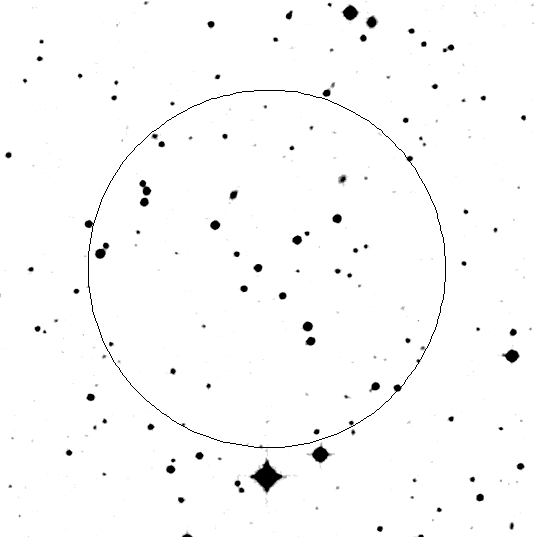
- GCN NOTICE
TITLE: GCN/SWIFT NOTICE
NOTICE_DATE: Fri 26 May 06 16:30:32 UT
NOTICE_TYPE: Swift-XRT Image
TRIGGER_NUM: 211957, Seg_Num: 0
GRB_RA: 232.8267d {+15h 31m 18.4s} (J2000),
232.9085d {+15h 31m 38.0s} (current),
232.1876d {+15h 28m 45.0s} (1950)
GRB_DEC: +0.2864d {+00d 17' 11.0"} (J2000),
+0.2649d {+00d 15' 53.6"} (current),
+0.4559d {+00d 27' 21.0"} (1950)
GRB_ERROR: 6.8 [arcsec, radius, statistical plus systematic]
GRB_INTEN: 21 [cnts]
IMG_START_DATE: 13881 TJD; 146 DOY; 06/05/26
IMG_START_TIME: 59383.18 SOD {16:29:43.18} UT, 73.2 [sec] since BAT Trigger Time
CENTROID_X: 226.60, raw= 227 [pixels]
CENTROID_Y: 309.67, raw= 310 [pixels]
ROLL: 335.02 [deg]
GAIN: 1
MODE: 3, Long Image mode
WAVEFORM: 134
EXPO_TIME: 2.50 [sec]
GRB_POS_XRT_Y: 25.62
GRB_POS_XRT_Z: -176.07
IMAGE_URL: sw00211957000msxps_rw.img
SUN_POSTN: 63.36d {+04h 13m 27s} +21.18d {+21d 10' 54"}
SUN_DIST: 156.25 [deg] Sun_angle= -11.3 [hr] (East of Sun)
MOON_POSTN: 55.09d {+03h 40m 22s} +23.93d {+23d 55' 48"}
MOON_DIST: 155.71 [deg]
MOON_ILLUM: 0 [%]
GAL_COORDS: 4.69, 43.19 [deg] galactic lon,lat of the burst
ECL_COORDS: 230.35, 18.76 [deg] ecliptic lon,lat of the burst
COMMENTS: SWIFT-XRT Image.

- GCN NOTICE
TITLE: GCN/SWIFT NOTICE
NOTICE_DATE: Fri 26 May 06 16:30:30 UT
NOTICE_TYPE: Swift-XRT Position
TRIGGER_NUM: 211957, Seg_Num: 0
GRB_RA: 232.8267d {+15h 31m 18.4s} (J2000),
232.9085d {+15h 31m 38.0s} (current),
232.1876d {+15h 28m 45.0s} (1950)
GRB_DEC: +0.2864d {+00d 17' 11.0"} (J2000),
+0.2649d {+00d 15' 53.6"} (current),
+0.4559d {+00d 27' 21.0"} (1950)
GRB_ERROR: 6.8 [arcsec radius, statistical plus systematic, 90% containment]
GRB_INTEN: 3.58e-10 [erg/cm2/sec]
GRB_SIGNIF: 4.58 [sigma]
IMG_START_DATE: 13881 TJD; 146 DOY; 06/05/26
IMG_START_TIME: 59383.18 SOD {16:29:43.18} UT, 73.2 [sec] since BAT Trigger Time
TAM[0-3]: 327.65 237.20 261.38 243.29
AMPLIFIER: 2
WAVEFORM: 134
SUN_POSTN: 63.36d {+04h 13m 27s} +21.18d {+21d 10' 54"}
SUN_DIST: 156.25 [deg] Sun_angle= -11.3 [hr] (East of Sun)
MOON_POSTN: 55.09d {+03h 40m 22s} +23.93d {+23d 55' 48"}
MOON_DIST: 155.71 [deg]
MOON_ILLUM: 0 [%]
GAL_COORDS: 4.69, 43.19 [deg] galactic lon,lat of the burst
ECL_COORDS: 230.35, 18.76 [deg] ecliptic lon,lat of the burst
COMMENTS: SWIFT-XRT Coordinates.
- GCN NOTICE
TITLE: GCN/SWIFT NOTICE
NOTICE_DATE: Fri 26 May 06 16:30:52 UT
NOTICE_TYPE: Swift-XRT Processed Image
TRIGGER_NUM: 211957, Seg_Num: 0
GRB_RA: 232.8267d {+15h 31m 18.4s} (J2000),
232.9085d {+15h 31m 38.0s} (current),
232.1876d {+15h 28m 45.0s} (1950)
GRB_DEC: +0.2864d {+00d 17' 11.0"} (J2000),
+0.2649d {+00d 15' 53.6"} (current),
+0.4559d {+00d 27' 21.0"} (1950)
GRB_ERROR: 6.8 [arcsec, radius, statistical plus systematic]
GRB_INTEN: 21 [cnts]
IMG_START_DATE: 13881 TJD; 146 DOY; 06/05/26
IMG_START_TIME: 59383.18 SOD {16:29:43.18} UT, 73.2 [sec] since BAT Trigger Time
CENTROID_X: 226.60, raw= 227 [pixels]
CENTROID_Y: 309.67, raw= 310 [pixels]
ROLL: 335.02 [deg]
GAIN: 1
MODE: 3, Long Image mode
WAVEFORM: 134
EXPO_TIME: 2.50 [sec]
GRB_POS_XRT_Y: 25.62
GRB_POS_XRT_Z: -176.07
IMAGE_URL: sw00211957000msxps_rw.img
SUN_POSTN: 63.36d {+04h 13m 27s} +21.18d {+21d 10' 55"}
SUN_DIST: 156.25 [deg] Sun_angle= -11.3 [hr] (East of Sun)
MOON_POSTN: 55.10d {+03h 40m 23s} +23.93d {+23d 55' 52"}
MOON_DIST: 155.71 [deg]
MOON_ILLUM: 0 [%]
GAL_COORDS: 4.69, 43.19 [deg] galactic lon,lat of the burst
ECL_COORDS: 230.35, 18.76 [deg] ecliptic lon,lat of the burst
COMMENTS: SWIFT-XRT Processed Image.

- GCN NOTICE
TITLE: GCN/SWIFT NOTICE
NOTICE_DATE: Fri 26 May 06 16:33:32 UT
NOTICE_TYPE: Swift-UVOT Source List
TRIGGER_NUM: 211957, Seg_Num: 0
POINT_RA: 232.853d {+15h 31m 25s} (J2000)
POINT_DEC: +0.245d {+00d 14' 42"} (J2000)
POINT_ROLL: 335.018d
IMG_START_DATE: 13881 TJD; 146 DOY; 06/05/26
IMG_START_TIME: 59391.29 SOD {16:29:51.29} UT, 81.3 [sec] since BAT Trigger Time
FILTER: 10, White
BKG_MEAN: 1.647
N_STARS: 44
X_OFFSET: 757 [pixels]
Y_OFFSET: 353 [pixels]
X_MAX: 1716 [pixels]
Y_MAX: 1312 [pixels]
DET_THRESH: 11
PHOTO_THRESH: 5
SL_URL: sw00211957000msufc0081.fits
SUN_POSTN: 63.36d {+04h 13m 27s} +21.18d {+21d 10' 56"}
SUN_DIST: 156.29 [deg] Sun_angle= -11.3 [hr] (East of Sun)
MOON_POSTN: 55.12d {+03h 40m 29s} +23.94d {+23d 56' 17"}
MOON_DIST: 155.75 [deg]
MOON_ILLUM: 0 [%]
GAL_COORDS: 4.67, 43.14 [deg] galactic lon,lat of the pointing direction
ECL_COORDS: 230.39, 18.72 [deg] ecliptic lon,lat of the pointing direction
COMMENTS: SWIFT-UVOT Source List.
- GCN NOTICE
TITLE: GCN/SWIFT NOTICE
NOTICE_DATE: Fri 26 May 06 16:34:07 UT
NOTICE_TYPE: Swift-UVOT Image
TRIGGER_NUM: 211957, Seg_Num: 0
POINT_RA: 232.853d {+15h 31m 25s} (J2000)
POINT_DEC: +0.245d {+00d 14' 42"} (J2000)
ROLL: 335.018d
IMG_START_DATE: 13881 TJD; 146 DOY; 06/05/26
IMG_START_TIME: 59391.29 SOD {16:29:51.29} UT, 81.3 [sec] since BAT Trigger Time
FILTER: 10, White
EXPOSURE_ID: 170353792
X_OFFSET: 1077 [pixels]
Y_OFFSET: 673 [pixels]
WIDTH: 160 [pixels]
HEIGHT: 160 [pixels]
X_GRB_POS: 1237
Y_GRB_POS: 833
BINNING_INDEX: 1
IM_URL: sw00211957000msuni0081.fits
SUN_POSTN: 63.36d {+04h 13m 27s} +21.18d {+21d 10' 56"}
SUN_DIST: 156.29 [deg] Sun_angle= -11.3 [hr] (East of Sun)
MOON_POSTN: 55.13d {+03h 40m 31s} +23.94d {+23d 56' 22"}
MOON_DIST: 155.74 [deg]
MOON_ILLUM: 0 [%]
GAL_COORDS: 4.67, 43.14 [deg] galactic lon,lat of the pointing direction
ECL_COORDS: 230.39, 18.72 [deg] ecliptic lon,lat of the pointing direction
COMMENTS: SWIFT-UVOT Image.
COMMENTS: The GRB Position came from the Window Position in the Mode Command.
COMMENTS: The image has 2x2 binning (compression).
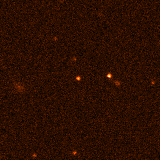
- GCN NOTICE
TITLE: GCN/SWIFT NOTICE
NOTICE_DATE: Fri 26 May 06 16:36:39 UT
NOTICE_TYPE: Swift-UVOT Processed Source List
TRIGGER_NUM: 211957, Seg_Num: 0
POINT_RA: 232.853d {+15h 31m 25s} (J2000)
POINT_DEC: +0.245d {+00d 14' 42"} (J2000)
POINT_ROLL: 335.018d
IMG_START_DATE: 13881 TJD; 146 DOY; 06/05/26
IMG_START_TIME: 59391.29 SOD {16:29:51.29} UT, 81.3 [sec] since BAT Trigger Time
FILTER: 10, White
BKG_MEAN: 1.647
N_STARS: 44
X_OFFSET: 757 [pixels]
Y_OFFSET: 353 [pixels]
X_MAX: 1716 [pixels]
Y_MAX: 1312 [pixels]
DET_THRESH: 11
PHOTO_THRESH: 5
SL_URL: sw00211957000msufc0081.fits
SUN_POSTN: 63.37d {+04h 13m 28s} +21.18d {+21d 10' 57"}
SUN_DIST: 156.29 [deg] Sun_angle= -11.3 [hr] (East of Sun)
MOON_POSTN: 55.15d {+03h 40m 37s} +23.95d {+23d 56' 46"}
MOON_DIST: 155.73 [deg]
MOON_ILLUM: 0 [%]
GAL_COORDS: 4.67, 43.14 [deg] galactic lon,lat of the pointing direction
ECL_COORDS: 230.39, 18.72 [deg] ecliptic lon,lat of the pointing direction
COMMENTS: SWIFT-UVOT Processed Source List.
COMMENTS: All 4 attachments are included.
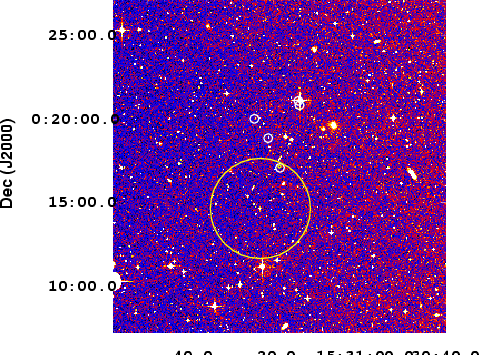
- GCN NOTICE
TITLE: GCN/SWIFT NOTICE
NOTICE_DATE: Fri 26 May 06 16:37:46 UT
NOTICE_TYPE: Swift-UVOT Processed Image
TRIGGER_NUM: 211957, Seg_Num: 0
POINT_RA: 232.853d {+15h 31m 25s} (J2000)
POINT_DEC: +0.245d {+00d 14' 42"} (J2000)
ROLL: 335.018d
IMG_START_DATE: 13881 TJD; 146 DOY; 06/05/26
IMG_START_TIME: 59391.29 SOD {16:29:51.29} UT, 81.3 [sec] since BAT Trigger Time
FILTER: 10, White
EXPOSURE_ID: 170353792
X_OFFSET: 1077 [pixels]
Y_OFFSET: 673 [pixels]
WIDTH: 160 [pixels]
HEIGHT: 160 [pixels]
X_GRB_POS: 1237
Y_GRB_POS: 833
BINNING_INDEX: 1
IM_URL: sw00211957000msuni0081.fits
SUN_POSTN: 63.37d {+04h 13m 28s} +21.18d {+21d 10' 57"}
SUN_DIST: 156.29 [deg] Sun_angle= -11.3 [hr] (East of Sun)
MOON_POSTN: 55.17d {+03h 40m 40s} +23.95d {+23d 56' 57"}
MOON_DIST: 155.73 [deg]
MOON_ILLUM: 0 [%]
GAL_COORDS: 4.67, 43.14 [deg] galactic lon,lat of the pointing direction
ECL_COORDS: 230.39, 18.72 [deg] ecliptic lon,lat of the pointing direction
COMMENTS: SWIFT-UVOT Processed Image.
COMMENTS: The GRB Position came from the Window Position in the Mode Command.
COMMENTS: The image has 2x2 binning (compression).
COMMENTS: All 4 attachments are included.
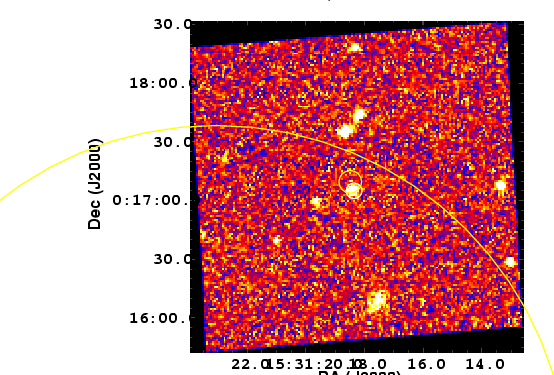
- GCN NOTICE
TITLE: GCN/SWIFT NOTICE
NOTICE_DATE: Fri 26 May 06 16:39:30 UT
NOTICE_TYPE: Swift-UVOT Source List
TRIGGER_NUM: 211957, Seg_Num: 0
POINT_RA: 232.852d {+15h 31m 25s} (J2000)
POINT_DEC: +0.246d {+00d 14' 45"} (J2000)
POINT_ROLL: 335.017d
IMG_START_DATE: 13881 TJD; 146 DOY; 06/05/26
IMG_START_TIME: 59496.48 SOD {16:31:36.48} UT, 186.5 [sec] since BAT Trigger Time
FILTER: 3, V
BKG_MEAN: 1.519
N_STARS: 80
X_OFFSET: 757 [pixels]
Y_OFFSET: 353 [pixels]
X_MAX: 1716 [pixels]
Y_MAX: 1312 [pixels]
DET_THRESH: 10
PHOTO_THRESH: 5
SL_URL: sw00211957000msufc0186.fits
SUN_POSTN: 63.37d {+04h 13m 28s} +21.18d {+21d 10' 58"}
SUN_DIST: 156.29 [deg] Sun_angle= -11.3 [hr] (East of Sun)
MOON_POSTN: 55.18d {+03h 40m 44s} +23.95d {+23d 57' 13"}
MOON_DIST: 155.72 [deg]
MOON_ILLUM: 0 [%]
GAL_COORDS: 4.67, 43.14 [deg] galactic lon,lat of the pointing direction
ECL_COORDS: 230.39, 18.72 [deg] ecliptic lon,lat of the pointing direction
COMMENTS: SWIFT-UVOT Source List.
- GCN NOTICE
TITLE: GCN/SWIFT NOTICE
NOTICE_DATE: Fri 26 May 06 16:41:27 UT
NOTICE_TYPE: Swift-UVOT Processed Source List
TRIGGER_NUM: 211957, Seg_Num: 0
POINT_RA: 232.852d {+15h 31m 25s} (J2000)
POINT_DEC: +0.246d {+00d 14' 45"} (J2000)
POINT_ROLL: 335.017d
IMG_START_DATE: 13881 TJD; 146 DOY; 06/05/26
IMG_START_TIME: 59496.48 SOD {16:31:36.48} UT, 186.5 [sec] since BAT Trigger Time
FILTER: 3, V
BKG_MEAN: 1.519
N_STARS: 80
X_OFFSET: 757 [pixels]
Y_OFFSET: 353 [pixels]
X_MAX: 1716 [pixels]
Y_MAX: 1312 [pixels]
DET_THRESH: 10
PHOTO_THRESH: 5
SL_URL: sw00211957000msufc0186.fits
SUN_POSTN: 63.37d {+04h 13m 29s} +21.18d {+21d 10' 59"}
SUN_DIST: 156.29 [deg] Sun_angle= -11.3 [hr] (East of Sun)
MOON_POSTN: 55.20d {+03h 40m 49s} +23.96d {+23d 57' 32"}
MOON_DIST: 155.72 [deg]
MOON_ILLUM: 0 [%]
GAL_COORDS: 4.67, 43.14 [deg] galactic lon,lat of the pointing direction
ECL_COORDS: 230.39, 18.72 [deg] ecliptic lon,lat of the pointing direction
COMMENTS: SWIFT-UVOT Processed Source List.
COMMENTS: All 4 attachments are included.
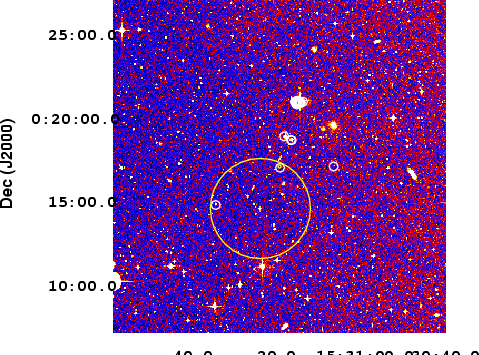
- GCN NOTICE
TITLE: GCN/SWIFT NOTICE
NOTICE_DATE: Fri 26 May 06 16:41:38 UT
NOTICE_TYPE: Swift-UVOT Image
TRIGGER_NUM: 211957, Seg_Num: 0
POINT_RA: 232.852d {+15h 31m 25s} (J2000)
POINT_DEC: +0.246d {+00d 14' 45"} (J2000)
ROLL: 335.017d
IMG_START_DATE: 13881 TJD; 146 DOY; 06/05/26
IMG_START_TIME: 59496.48 SOD {16:31:36.48} UT, 186.5 [sec] since BAT Trigger Time
FILTER: 3, V
EXPOSURE_ID: 170353897
X_OFFSET: 1077 [pixels]
Y_OFFSET: 673 [pixels]
WIDTH: 160 [pixels]
HEIGHT: 160 [pixels]
X_GRB_POS: 1237
Y_GRB_POS: 833
BINNING_INDEX: 1
IM_URL: sw00211957000msuni0186.fits
SUN_POSTN: 63.37d {+04h 13m 29s} +21.18d {+21d 10' 59"}
SUN_DIST: 156.29 [deg] Sun_angle= -11.3 [hr] (East of Sun)
MOON_POSTN: 55.20d {+03h 40m 49s} +23.96d {+23d 57' 34"}
MOON_DIST: 155.72 [deg]
MOON_ILLUM: 0 [%]
GAL_COORDS: 4.67, 43.14 [deg] galactic lon,lat of the pointing direction
ECL_COORDS: 230.39, 18.72 [deg] ecliptic lon,lat of the pointing direction
COMMENTS: SWIFT-UVOT Image.
COMMENTS: The GRB Position came from the Window Position in the Mode Command.
COMMENTS: The image has 2x2 binning (compression).
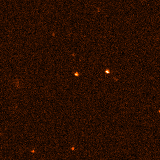
- GCN NOTICE
TITLE: GCN/SWIFT NOTICE
NOTICE_DATE: Fri 26 May 06 16:43:53 UT
NOTICE_TYPE: Swift-UVOT Processed Image
TRIGGER_NUM: 211957, Seg_Num: 0
POINT_RA: 232.852d {+15h 31m 25s} (J2000)
POINT_DEC: +0.246d {+00d 14' 45"} (J2000)
ROLL: 335.017d
IMG_START_DATE: 13881 TJD; 146 DOY; 06/05/26
IMG_START_TIME: 59496.48 SOD {16:31:36.48} UT, 186.5 [sec] since BAT Trigger Time
FILTER: 3, V
EXPOSURE_ID: 170353897
X_OFFSET: 1077 [pixels]
Y_OFFSET: 673 [pixels]
WIDTH: 160 [pixels]
HEIGHT: 160 [pixels]
X_GRB_POS: 1237
Y_GRB_POS: 833
BINNING_INDEX: 1
IM_URL: sw00211957000msuni0186.fits
SUN_POSTN: 63.37d {+04h 13m 29s} +21.18d {+21d 11' 00"}
SUN_DIST: 156.29 [deg] Sun_angle= -11.3 [hr] (East of Sun)
MOON_POSTN: 55.23d {+03h 40m 55s} +23.97d {+23d 57' 55"}
MOON_DIST: 155.71 [deg]
MOON_ILLUM: 0 [%]
GAL_COORDS: 4.67, 43.14 [deg] galactic lon,lat of the pointing direction
ECL_COORDS: 230.39, 18.72 [deg] ecliptic lon,lat of the pointing direction
COMMENTS: SWIFT-UVOT Processed Image.
COMMENTS: The GRB Position came from the Window Position in the Mode Command.
COMMENTS: The image has 2x2 binning (compression).
COMMENTS: All 4 attachments are included.
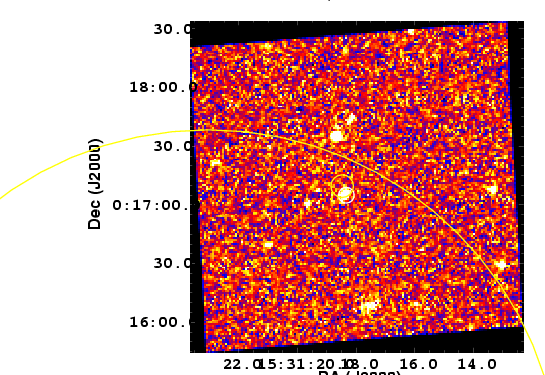
- GCN NOTICE
TITLE: GCN/SWIFT NOTICE
NOTICE_DATE: Fri 26 May 06 16:34:27 UT
NOTICE_TYPE: Swift-BAT GRB Lightcurve
TRIGGER_NUM: 211957, Seg_Num: 0
GRB_RA: 232.845d {+15h 31m 23s} (J2000),
232.927d {+15h 31m 43s} (current),
232.206d {+15h 28m 49s} (1950)
GRB_DEC: +0.244d {+00d 14' 39"} (J2000),
+0.223d {+00d 13' 22"} (current),
+0.414d {+00d 24' 49"} (1950)
GRB_DATE: 13881 TJD; 146 DOY; 06/05/26
GRB_TIME: 59309.95 SOD {16:28:29.95} UT
TRIGGER_INDEX: 124
GRB_PHI: 52.21 [deg]
GRB_THETA: 24.87 [deg]
DELTA_TIME: -76.00 [sec]
TRIGGER_DUR: 0.512 [sec]
SOLN_STATUS: 0x3
RATE_SIGNIF: 20.34 [sigma]
IMAGE_SIGNIF: 9.05 [sigma]
LC_URL: sw00211957000msb.lc
SUN_POSTN: 63.36d {+04h 13m 27s} +21.18d {+21d 10' 56"}
SUN_DIST: 156.29 [deg] Sun_angle= -11.3 [hr] (East of Sun)
MOON_POSTN: 55.13d {+03h 40m 32s} +23.94d {+23d 56' 26"}
MOON_DIST: 155.74 [deg]
MOON_ILLUM: 0 [%]
GAL_COORDS: 4.66, 43.14 [deg] galactic lon,lat of the burst (or transient)
ECL_COORDS: 230.38, 18.72 [deg] ecliptic lon,lat of the burst (or transient)
COMMENTS: SWIFT-BAT GRB Lightcurve.
COMMENTS:
COMMENTS: The next comments were copied from the BAT_POS Notice:
COMMENTS: This is a rate trigger.
COMMENTS: A point_source was found.
COMMENTS: This does not match any source in the on-board catalog.
COMMENTS: This does not match any source in the ground catalog.
COMMENTS: This is a GRB.
COMMENTS: This trigger occurred at longitude,latitude = 69.26,-18.86 [deg].
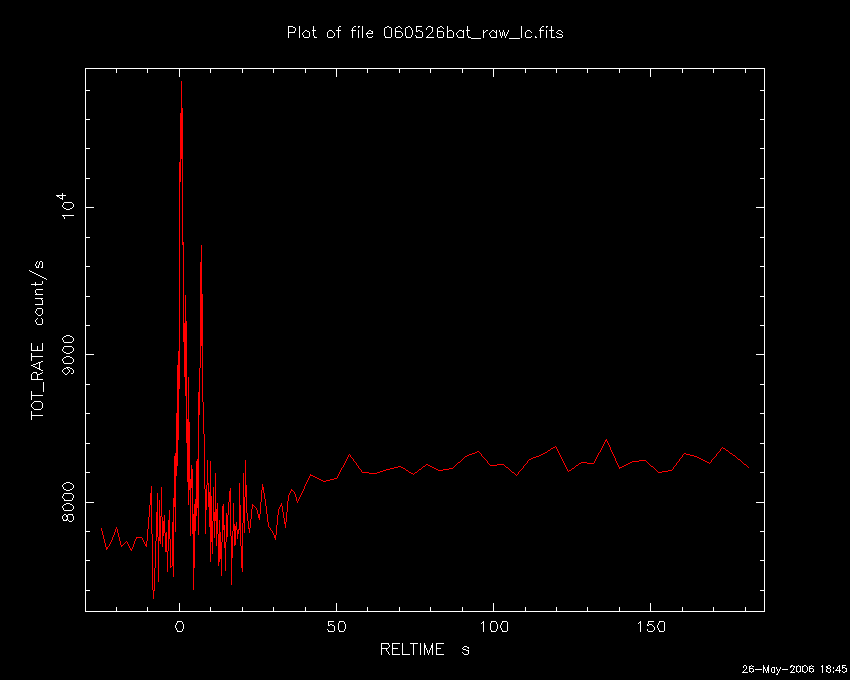
- GCN Circular #5162
S. Campana (INAF-OAB), S. D. Barthelmy (GSFC), P. T. Boyd (NASA/GSFC),
P. J. Brown (PSU), D. N. Burrows (PSU), J. R. Cummings (NASA/ORAU),
C. G. Guidorzi (Univ Bicocca&OAB), S. T. Holland (GSFC/USRA),
J. A. Kennea (PSU), C. B. Markwardt (GSFC/UMD),
F. E. Marshall (NASA/GSFC), A. Moretti (INAF-OAB),
K. L. Page (U Leicester), M. Stamatikos (NASA/ORAU),
G. Tagliaferri (INAF-OAB) and D. E. Vanden Berk (PSU) report on
behalf of the Swift Team:
At 16:28:30 UT, the Swift Burst Alert Telescope (BAT) triggered and
located GRB 060526 (trigger=211957). Swift slewed immediately to the burst.
The BAT on-board calculated location is RA,Dec 232.845, +0.244
{15h 31m 23s, +00d 14' 39"} (J2000) with an uncertainty of 3 arcmin
(radius, 90% containment, including systematic uncertainty).
The BAT light curve shows multiple peaks starting at T-3 sec out to
T+15 sec. The peak count rate was ~2600 counts/sec (15-350 keV),
at ~1 sec after the trigger.
The XRT began observing the field at 16:29:43 UT, 73 seconds after the
BAT trigger. XRT found an uncatalogued X-ray source located at
RA(J2000) = 15h 31m 18.4s, Dec(J2000) = +00d 17' 11.0", with an
estimated uncertainty of 6.8 arcseconds (90% confidence radius). This
location is 166 arcseconds from the BAT on-board position, within the
BAT error circle. The initial flux in the 2.5s image was 3.6e-10
erg/cm2/s (0.2-10 keV).
UVOT took a finding chart exposure of 100 seconds with the White
(160-650 nm) filter starting 81 seconds after the BAT trigger. There
is a candidate afterglow in the rapidly available 2.7'x2.7' sub-image
at (RA,DEC) (J2000) of (232.8265,0.2847) or
(15h31m18.36s,+00o17'04.9") with a 1-sigma error radius of about 0.5
arc sec. This position is 6.2 arc sec. from the center of the XRT
error circle. The estimated magnitude is 17.6 with a 1-sigma error of
about 0.5 mag. No correction has been made for the expected extinction
corresponding to E(B-V) of 0.07.
- GCN NOTICE
TITLE: GCN/SWIFT NOTICE
NOTICE_DATE: Fri 26 May 06 16:50:00 UT
NOTICE_TYPE: Swift-UVOT Source List
TRIGGER_NUM: 211957, Seg_Num: 0
POINT_RA: 232.852d {+15h 31m 24s} (J2000)
POINT_DEC: +0.246d {+00d 14' 45"} (J2000)
POINT_ROLL: 335.017d
IMG_START_DATE: 13881 TJD; 146 DOY; 06/05/26
IMG_START_TIME: 60174.34 SOD {16:42:54.34} UT, 864.4 [sec] since BAT Trigger Time
FILTER: 3, V
BKG_MEAN: 1.586
N_STARS: 82
X_OFFSET: 757 [pixels]
Y_OFFSET: 353 [pixels]
X_MAX: 1716 [pixels]
Y_MAX: 1312 [pixels]
DET_THRESH: 10
PHOTO_THRESH: 5
SL_URL: sw00211957000msufc0864.fits
SUN_POSTN: 63.38d {+04h 13m 30s} +21.18d {+21d 11' 03"}
SUN_DIST: 156.29 [deg] Sun_angle= -11.3 [hr] (East of Sun)
MOON_POSTN: 55.29d {+03h 41m 09s} +23.98d {+23d 58' 53"}
MOON_DIST: 155.69 [deg]
MOON_ILLUM: 0 [%]
GAL_COORDS: 4.67, 43.14 [deg] galactic lon,lat of the pointing direction
ECL_COORDS: 230.39, 18.72 [deg] ecliptic lon,lat of the pointing direction
COMMENTS: SWIFT-UVOT Source List.
- GCN NOTICE
TITLE: GCN/SWIFT NOTICE
NOTICE_DATE: Fri 26 May 06 16:51:43 UT
NOTICE_TYPE: Swift-UVOT Processed Source List
TRIGGER_NUM: 211957, Seg_Num: 0
POINT_RA: 232.852d {+15h 31m 24s} (J2000)
POINT_DEC: +0.246d {+00d 14' 45"} (J2000)
POINT_ROLL: 335.017d
IMG_START_DATE: 13881 TJD; 146 DOY; 06/05/26
IMG_START_TIME: 60174.34 SOD {16:42:54.34} UT, 864.4 [sec] since BAT Trigger Time
FILTER: 3, V
BKG_MEAN: 1.586
N_STARS: 82
X_OFFSET: 757 [pixels]
Y_OFFSET: 353 [pixels]
X_MAX: 1716 [pixels]
Y_MAX: 1312 [pixels]
DET_THRESH: 10
PHOTO_THRESH: 5
SL_URL: sw00211957000msufc0864.fits
SUN_POSTN: 63.38d {+04h 13m 30s} +21.18d {+21d 11' 03"}
SUN_DIST: 156.28 [deg] Sun_angle= -11.3 [hr] (East of Sun)
MOON_POSTN: 55.31d {+03h 41m 14s} +23.99d {+23d 59' 09"}
MOON_DIST: 155.68 [deg]
MOON_ILLUM: 0 [%]
GAL_COORDS: 4.67, 43.14 [deg] galactic lon,lat of the pointing direction
ECL_COORDS: 230.39, 18.72 [deg] ecliptic lon,lat of the pointing direction
COMMENTS: SWIFT-UVOT Processed Source List.
COMMENTS: All 4 attachments are included.
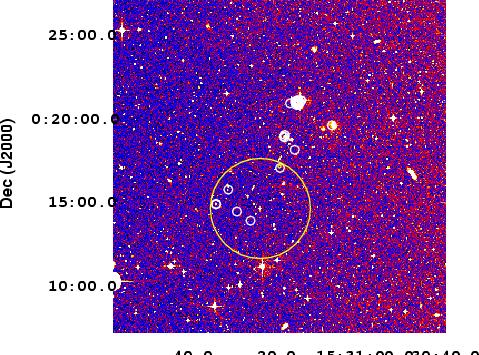
- GCN NOTICE
TITLE: GCN/SWIFT NOTICE
NOTICE_DATE: Fri 26 May 06 16:52:03 UT
NOTICE_TYPE: Swift-UVOT Image
TRIGGER_NUM: 211957, Seg_Num: 0
POINT_RA: 232.852d {+15h 31m 24s} (J2000)
POINT_DEC: +0.246d {+00d 14' 45"} (J2000)
ROLL: 335.017d
IMG_START_DATE: 13881 TJD; 146 DOY; 06/05/26
IMG_START_TIME: 60174.34 SOD {16:42:54.34} UT, 864.4 [sec] since BAT Trigger Time
FILTER: 3, V
EXPOSURE_ID: 170354575
X_OFFSET: 1077 [pixels]
Y_OFFSET: 673 [pixels]
WIDTH: 160 [pixels]
HEIGHT: 160 [pixels]
X_GRB_POS: 1237
Y_GRB_POS: 833
BINNING_INDEX: 1
IM_URL: sw00211957000msuni0864.fits
SUN_POSTN: 63.38d {+04h 13m 30s} +21.18d {+21d 11' 04"}
SUN_DIST: 156.28 [deg] Sun_angle= -11.3 [hr] (East of Sun)
MOON_POSTN: 55.31d {+03h 41m 14s} +23.99d {+23d 59' 12"}
MOON_DIST: 155.68 [deg]
MOON_ILLUM: 0 [%]
GAL_COORDS: 4.67, 43.14 [deg] galactic lon,lat of the pointing direction
ECL_COORDS: 230.39, 18.72 [deg] ecliptic lon,lat of the pointing direction
COMMENTS: SWIFT-UVOT Image.
COMMENTS: The GRB Position came from the Window Position in the Mode Command.
COMMENTS: The image has 2x2 binning (compression).
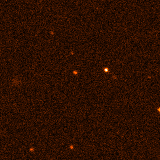
- GCN NOTICE
TITLE: GCN/SWIFT NOTICE
NOTICE_DATE: Fri 26 May 06 16:52:36 UT
NOTICE_TYPE: Swift-UVOT Source List
TRIGGER_NUM: 211957, Seg_Num: 0
POINT_RA: 232.852d {+15h 31m 25s} (J2000)
POINT_DEC: +0.246d {+00d 14' 45"} (J2000)
POINT_ROLL: 335.017d
IMG_START_DATE: 13881 TJD; 146 DOY; 06/05/26
IMG_START_TIME: 60581.98 SOD {16:49:41.98} UT, 1272.0 [sec] since BAT Trigger Time
FILTER: 10, White
BKG_MEAN: 1.654
N_STARS: 52
X_OFFSET: 757 [pixels]
Y_OFFSET: 353 [pixels]
X_MAX: 1716 [pixels]
Y_MAX: 1312 [pixels]
DET_THRESH: 11
PHOTO_THRESH: 5
SL_URL: sw00211957000msufc1272.fits
SUN_POSTN: 63.38d {+04h 13m 31s} +21.18d {+21d 11' 04"}
SUN_DIST: 156.28 [deg] Sun_angle= -11.3 [hr] (East of Sun)
MOON_POSTN: 55.32d {+03h 41m 16s} +23.99d {+23d 59' 17"}
MOON_DIST: 155.68 [deg]
MOON_ILLUM: 0 [%]
GAL_COORDS: 4.67, 43.14 [deg] galactic lon,lat of the pointing direction
ECL_COORDS: 230.39, 18.72 [deg] ecliptic lon,lat of the pointing direction
COMMENTS: SWIFT-UVOT Source List.
- GCN NOTICE
TITLE: GCN/SWIFT NOTICE
NOTICE_DATE: Fri 26 May 06 16:55:32 UT
NOTICE_TYPE: Swift-UVOT Processed Source List
TRIGGER_NUM: 211957, Seg_Num: 0
POINT_RA: 232.852d {+15h 31m 25s} (J2000)
POINT_DEC: +0.246d {+00d 14' 45"} (J2000)
POINT_ROLL: 335.017d
IMG_START_DATE: 13881 TJD; 146 DOY; 06/05/26
IMG_START_TIME: 60581.98 SOD {16:49:41.98} UT, 1272.0 [sec] since BAT Trigger Time
FILTER: 10, White
BKG_MEAN: 1.654
N_STARS: 52
X_OFFSET: 757 [pixels]
Y_OFFSET: 353 [pixels]
X_MAX: 1716 [pixels]
Y_MAX: 1312 [pixels]
DET_THRESH: 11
PHOTO_THRESH: 5
SL_URL: sw00211957000msufc1272.fits
SUN_POSTN: 63.38d {+04h 13m 31s} +21.18d {+21d 11' 05"}
SUN_DIST: 156.28 [deg] Sun_angle= -11.3 [hr] (East of Sun)
MOON_POSTN: 55.35d {+03h 41m 23s} +24.00d {+23d 59' 45"}
MOON_DIST: 155.67 [deg]
MOON_ILLUM: 0 [%]
GAL_COORDS: 4.67, 43.14 [deg] galactic lon,lat of the pointing direction
ECL_COORDS: 230.39, 18.72 [deg] ecliptic lon,lat of the pointing direction
COMMENTS: SWIFT-UVOT Processed Source List.
COMMENTS: All 4 attachments are included.
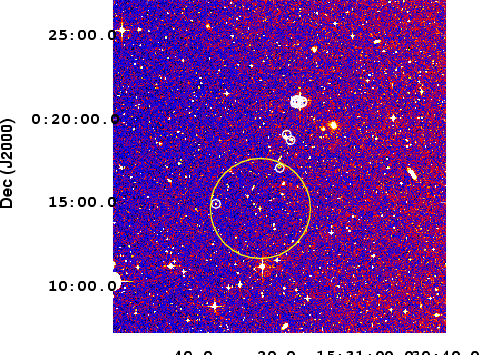
- GCN NOTICE
TITLE: GCN/SWIFT NOTICE
NOTICE_DATE: Fri 26 May 06 16:56:37 UT
NOTICE_TYPE: Swift-UVOT Processed Image
TRIGGER_NUM: 211957, Seg_Num: 0
POINT_RA: 232.852d {+15h 31m 25s} (J2000)
POINT_DEC: +0.246d {+00d 14' 45"} (J2000)
ROLL: 335.017d
IMG_START_DATE: 13881 TJD; 146 DOY; 06/05/26
IMG_START_TIME: 60581.98 SOD {16:49:41.98} UT, 1272.0 [sec] since BAT Trigger Time
FILTER: 10, White
EXPOSURE_ID: 170354983
X_OFFSET: 1077 [pixels]
Y_OFFSET: 673 [pixels]
WIDTH: 160 [pixels]
HEIGHT: 160 [pixels]
X_GRB_POS: 1237
Y_GRB_POS: 833
BINNING_INDEX: 1
IM_URL: sw00211957000msuni1272.fits
SUN_POSTN: 63.38d {+04h 13m 31s} +21.18d {+21d 11' 06"}
SUN_DIST: 156.28 [deg] Sun_angle= -11.3 [hr] (East of Sun)
MOON_POSTN: 55.36d {+03h 41m 25s} +24.00d {+23d 59' 55"}
MOON_DIST: 155.66 [deg]
MOON_ILLUM: 0 [%]
GAL_COORDS: 4.67, 43.14 [deg] galactic lon,lat of the pointing direction
ECL_COORDS: 230.39, 18.72 [deg] ecliptic lon,lat of the pointing direction
COMMENTS: SWIFT-UVOT Processed Image.
COMMENTS: The GRB Position came from the Window Position in the Mode Command.
COMMENTS: The image has 2x2 binning (compression).
COMMENTS: All 4 attachments are included.
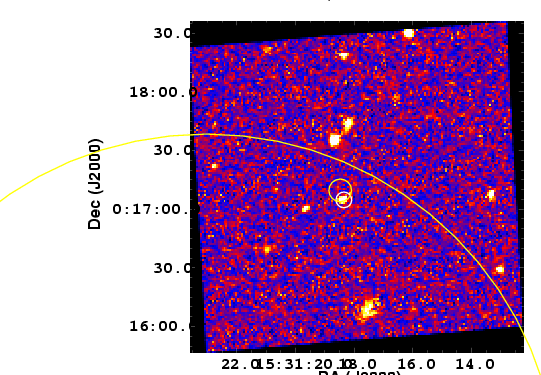
- GCN NOTICE
TITLE: GCN/SWIFT NOTICE
NOTICE_DATE: Fri 26 May 06 16:53:25 UT
NOTICE_TYPE: Swift-UVOT Processed Image
TRIGGER_NUM: 211957, Seg_Num: 0
POINT_RA: 232.852d {+15h 31m 25s} (J2000)
POINT_DEC: +0.246d {+00d 14' 45"} (J2000)
ROLL: 335.017d
IMG_START_DATE: 13881 TJD; 146 DOY; 06/05/26
IMG_START_TIME: 60581.98 SOD {16:49:41.98} UT, 1272.0 [sec] since BAT Trigger Time
FILTER: 10, White
EXPOSURE_ID: 170354983
X_OFFSET: 1077 [pixels]
Y_OFFSET: 673 [pixels]
WIDTH: 160 [pixels]
HEIGHT: 160 [pixels]
X_GRB_POS: 1237
Y_GRB_POS: 833
BINNING_INDEX: 1
IM_URL: sw00211957000msuni1272.fits
SUN_POSTN: 63.38d {+04h 13m 31s} +21.18d {+21d 11' 04"}
SUN_DIST: 156.28 [deg] Sun_angle= -11.3 [hr] (East of Sun)
MOON_POSTN: 55.32d {+03h 41m 18s} +23.99d {+23d 59' 25"}
MOON_DIST: 155.67 [deg]
MOON_ILLUM: 0 [%]
GAL_COORDS: 4.67, 43.14 [deg] galactic lon,lat of the pointing direction
ECL_COORDS: 230.39, 18.72 [deg] ecliptic lon,lat of the pointing direction
COMMENTS: SWIFT-UVOT Processed Image.
COMMENTS: The GRB Position came from the Window Position in the Mode Command.
COMMENTS: The image has 2x2 binning (compression).
COMMENTS: If you have elected to receive attachments:
COMMENTS: The uvot_sky_image.img.gz file does not exist; skipping the attachment.
COMMENTS: The uvot_sources_image.fits.gz file does not exist; skipping the attachment.
COMMENTS: The uvot_catalog_image.fits.gz file does not exist; skipping the attachment.
COMMENTS: The uvot_field_image.ps.gz file does not exist; skipping the attachment.

- GCN NOTICE
TITLE: GCN/SWIFT NOTICE
NOTICE_DATE: Fri 26 May 06 16:53:22 UT
NOTICE_TYPE: Swift-UVOT Image
TRIGGER_NUM: 211957, Seg_Num: 0
POINT_RA: 232.852d {+15h 31m 25s} (J2000)
POINT_DEC: +0.246d {+00d 14' 45"} (J2000)
ROLL: 335.017d
IMG_START_DATE: 13881 TJD; 146 DOY; 06/05/26
IMG_START_TIME: 60581.98 SOD {16:49:41.98} UT, 1272.0 [sec] since BAT Trigger Time
FILTER: 10, White
EXPOSURE_ID: 170354983
X_OFFSET: 1077 [pixels]
Y_OFFSET: 673 [pixels]
WIDTH: 160 [pixels]
HEIGHT: 160 [pixels]
X_GRB_POS: 1237
Y_GRB_POS: 833
BINNING_INDEX: 1
IM_URL: sw00211957000msuni1272.fits
SUN_POSTN: 63.38d {+04h 13m 31s} +21.18d {+21d 11' 04"}
SUN_DIST: 156.28 [deg] Sun_angle= -11.3 [hr] (East of Sun)
MOON_POSTN: 55.32d {+03h 41m 18s} +23.99d {+23d 59' 24"}
MOON_DIST: 155.67 [deg]
MOON_ILLUM: 0 [%]
GAL_COORDS: 4.67, 43.14 [deg] galactic lon,lat of the pointing direction
ECL_COORDS: 230.39, 18.72 [deg] ecliptic lon,lat of the pointing direction
COMMENTS: SWIFT-UVOT Image.
COMMENTS: The GRB Position came from the Window Position in the Mode Command.
COMMENTS: The image has 2x2 binning (compression).
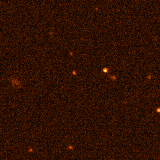
- GCN Circular #5163
S. Campana (INAF-OAB), S. D. Barthelmy (GSFC), D. N. Burrows (PSU),
N. Gehrels (NASA/GSFC), C. Guidorzi (Univ Bicocca&INAF-OAB),
J. A. Kennea (PSU), F. E. Marshall (NASA/GSFC),
K. M. McLean (LANL/UTD), A. Moretti (INAF-OAB),
M. Stamatikos (NASA/ORAU), G. Tagliaferri (INAF-OAB) and
D. E. Vanden Berk (PSU) report on behalf of the Swift Team:
Following up the report of the Swift GRB (Campana, et al., GCN 5162),
we note that the BAT lightcurve shows a well separated second period
of emission starting at ~T+220 sec and lasting until ~T+270 sec.
The shape of the emission is FRED-like. Based on the 4-band TDRSS
lightcurve, this second emission is significantly softer that the
original emission at T+0.
Based on initial data we find a refined XRT position of
RA(J2000): 15 31 18.27, DEC(J2000): +00 17 07.6, with an error
radius of 4.3 arcsec (90% confidence) and 3 arcsec from the previously
reported UVOT candidate position. The XRT light curve shows a sharp
increase in the count rate starting around T+220 s from burst trigger,
approximately coincident with the second BAT peak.
As shown in the table below, UVOT sees a fading afterglow in
the four finding chart exposures for this burst. In the table,
T is the time in seconds since the BAT trigger at the start
of the exposure.
T Exposure Filter Magnitude
83 100 White 17.6
188 400 V 17.2
866 400 V 17.8
1274 100 White 18.4
We note that the location of this burst is ~11.3 hours from the Sun
and therefore well suited for ground-based follow-ups.
There is no bright galaxy at this location in the archived SDSS images.
We will start receiving the full downlinked data set around 18:00 UT.
- GCN Circular #5164
Richard J. Cool (Arizona), Daniel J. Eisenstein (Arizona),
David W. Hogg (NYU), Michael R. Blanton (NYU), David
J. Schlegel (LBNL), J. Brinkmann (APO), Donald Q. Lamb
(Chicago), Donald P. Schneider (PSU), and Daniel E. Vanden
Berk (PSU) report:
The Sloan Digital Sky Survey (SDSS) imaged the field of
burst GRB060526 prior to the burst. As these data should
be useful as a pre-burst comparison and for calibrating
photometry, we are supplying the images and photometry
measurements for this GRB field to the community.
Data from the SDSS, including 5 FITS images, 3 JPGS, and
3 files of photometry and astrometry, are being placed
at http://mizar.as.arizona.edu/~grb/public/GRB060526
We supply FITS images in each of the 5 SDSS bands of a
8'x8' region centered on the GRB position (ra=232.827
(15:31:18.4), dec=0.286400 (00:17:11.0); GCN 5162),
as well as 3 gri color-composite JPGs (with different
stretches). The units in the FITS images are nanomaggies
per pixel. A pixel is 0.396 arcsec on a side. A nanomaggie
is a flux-density unit equal to 10^-9 of a magnitude
0 source or, to the extent that SDSS is an AB system,
3.631e-6 Jy. The FITS images have WCS astrometric
information.
In the file GRB060526_sdss.calstar.dat, we report
photometry and astrometry of 753 bright stars (r<20.5)
within 15' of the burst location. The magnitudes presented
in this file are asinh magnitudes as are standard in the
SDSS (Lupton 1999, AJ, 118, 1406). Beware that some of
these stars are not well-detected in the u-band; use the
errors and object flags to monitor data quality.
In the files GRB060526_sdss.objects_flux.dat and
GRB060526_sdss.objects_magnitudes.dat, we report photometry
of 1467 objects detected within 6' of the GRB position.
We have removed saturated objects and objects with
model magnitudes fainter than 23.0 in the r-band.
The fluxes listed in GRB060526_sdss.objects_flux.dat
are in nanomaggies while the magnitudes listed in
GRB060526_sdss.objects_magnitudes.dat are asinh magnitudes.
All quantities reported are standard SDSS photometry,
meaning that they are very close to AB zeropoints
and magnitudes are quoted in asinh magnitudes.
Photometric zeropoints are known to about 2% rms.
None of the photometry is corrected for dust extinction.
The Schlegel, Finkbeiner, and Davis (1998) predictions
for this region are A_U=0.337 mag, A_g=0.248 mag, A_r =
0.180 mag, A_i=0.136 mag, and A_z=0.097 mag.
The file GRB060526_sdss.spectro.dat contains a list of
the 5 objects with SDSS spectroscopy within 6 arcminutes
of the GRB position. In addition to the redshift and
1-sigma error for each object, this file also lists the
object spectroscopic classification.
SDSS astrometry is generally better than 0.1 arcsecond
per coordinate. Users requiring high precision astrometry
should take note that the SDSS astrometric system can
differ from other systems such as those used in other
notices; we have not checked the offsets in this region.
More detailed information pertaining to our SDSS GRB
releases can be found in our initial data release paper
(Cool et al. 2006, astro-ph/0601218). See the SDSS DR4
documentation for more details: http://www.sdss.org/dr4.
These data have been reduced using a slightly different
pipeline than that used for SDSS public data releases.
We cannot guarantee that the values here will exactly match
those in the data release in which these data are included.
In particular, we expect the photometric calibrations to
differ by of order 0.01 mag.
This note may be cited, but please also cite the SDSS data
release paper, Adelman-McCarthy et al. (2006, ApJS, in
press, astro-ph/0507711), when using the data or referring
to the technical documentation.
- GCN Circular #5165
John French (University College Dublin),
Martin Jelinek (IAA Granada),
on behalf of the Watcher collaboration report:
The Watcher 40cm robotic telescope, located at Boyden Observatory, South
Africa, began imaging the field of GRB 060526 (Barthelmy et al., GCN
5162) at 16:29:07, 36.2 seconds after the Swift trigger (19.6 seconds
after the GCN notice).
Preliminary analysis shows a varying source, consistent with the
position of the OT detected in the UVOT observations, with an R-band
magnitude of ~15 at T~60s. Analysis is on-going.
This message may be cited.
- GCN Circular #5166
E.S. Rykoff (U Mich), S.A. Yost (U Mich), H. Swan (U Mich), W.
Rujopakarn (U Mich), report on behalf of the ROTSE collaboration:
ROTSE-IIIc, located at the H.E.S.S. site at Mt. Gamsberg, Namibia,
responded to GRB 060526 (Swift trigger 211957, GCN 5162). The first
image was at 17:15:11.1 UT, 2801.1 s after the burst. The unfiltered
images are calibrated relative to USNO A2.0. We detect a 17.5th
magnitude, fading source with coordinates:
15:31:18.3 +00:17:03.7 (J2000)
This is consistent with the Swift/UVOT position reported in GCN 5162.
The afterglow did not fade significantly between 2800s and ~6000s
post-burst, when it was at ~ 17.5 mag. At 6000s the lightcurve had a
break, and started decaying as a smooth power-law with index ~-1. At
13000 s post-burst, the afterglow is at 18.4+/-0.05 mag. Observations
are continuing.
A jpeg image is available at
http://www.rotse.net/images/gsb211957_3c091-100_key.jpg
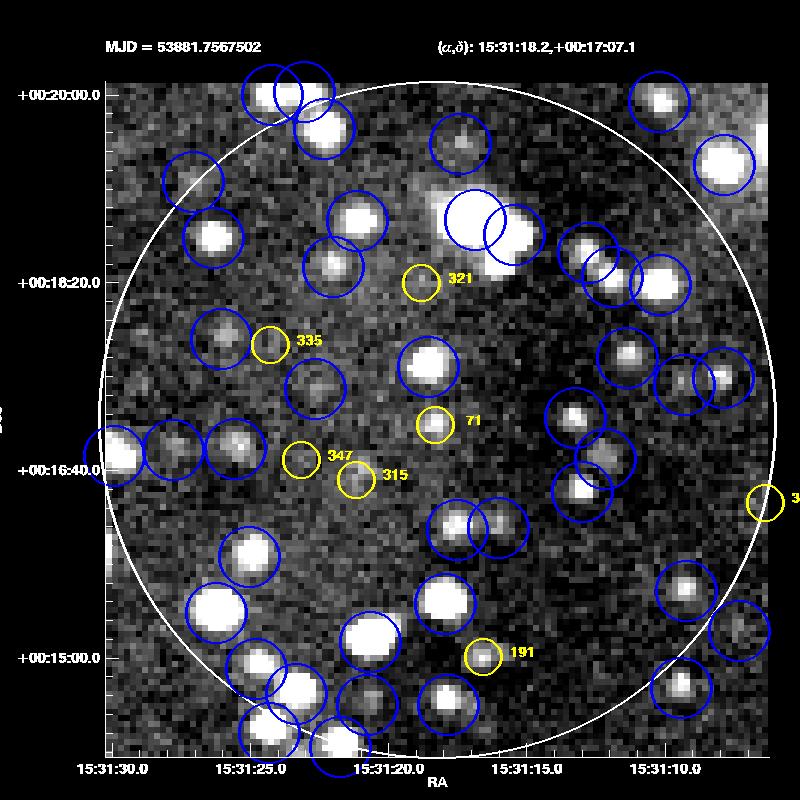
- GCN Circular #5167
S. Covino, G.L. Israel, F. Ghinassi, N. Pinilla, on behalf of the
CIBO collaboration, report:
We observed the optical counterpart of GRB 060526 (Campana et al. GCN
5162; French & Jelinek GCN 5165; Rykoff et al. GCN 5166) with the
3.6m TNG telescope located at the Canary Islands. V and R photometry
have been obtained with TNG+DOLoRES.
The afterglow is clearly detected at 21:00:56 UT (about 4:32 after
the burst) with R = 18.43 +- 0.04, assuming R = 15.0 for the USNO
star at RA,DEC 15:31:17.90, 00:15:28.8.
Further observations are in progress.
This message is citable.
- GCN Circular #5168
S. Campana (INAF-OAB), A. Moretti (INAF-OAB), C. Guidorzi
(Bicocca Univ. & INAF-OAB), G. Chincarini (Bicocca Univ. &
INAF-OAB), D.N. Burrows (PSU) on behalf of the Swift-XRT team
report:
We have analysed the first orbit of Swift/XRT data of GRB 060526
(Campana et al., GCN 5162 and GCN 5163) summing up 1773 s of data
in Photon Counting (PC) and 334 s in Window Timing (WT) mode,
respectively. We find a refined XRT position for this burst of:
RA(J2000) = 15 31 18.41
Dec(J2000) = +00 17 05.7
with an error of 3.6 arcseconds radius (90% containment).
This position is 2.8 arcseconds from the XRT position quoted by
Campana et al. (GCN 5163) and 1.1 arcseconds from the UVOT position.
The afterglow shows several states: the XRT started observing the
GRB at T+73 s. For the first 53 s (up to T+126 s) the XRT remained
in WT mode with a slowly decaying count rate (power law decay of
-1.4+/-0.9, 90% confidence). Then it switched to PC mode continuing
its slow decay up to T+206 s when a bright flare carry back the
XRT in WT mode. The flare is made of two flares with FRED-like
shape. The first peak reached >335 c/s (being slightly piled-up at
level count rate level) around T+240 s and the second about 200 c/s
around T+295 s. The decay from the first peak is very steep (as
measured from T), with an power law index of -7.7+/-0.7 and also
from the second with -8.6+/-0.2. The second flare shows some
structures close to the peak.
The PC data show the latest stages of the flare and then a break
to a much flatter decay (-0.7+/-0.5) around 600 s (further data
will improve the determination of the time of this break).
This does not allow a first prediction of the flux at one day.
From the spectral point of view, PC data before and after the flare
are consistent with a simple power law (photon index 1.8+/-0.2) at
a column density consistent with the Galactic value NH<1x10^21 cm^-2
(NH_g=6x10^20 cm^-2).
Flux in the first WT data is 1.7x10^-10 erg s^-1 cm^-2 (unabsorbed
0.3-10 keV) and in the last PC data 1.6x10^-10 erg s^-1 cm^-2.
Considering pre- and post-flare WT and PC data some spectral evolution
is observed, this can be explained with a spectral softening or a
column density decrease.
The spectrum of the first flare (excluded the brightest piled-up
portion) is consistent with a simple power law with photon index
around 1.8 and a column density larger than the values reported above,
likely indicating a fast evolving cut-off power law.
The second flare is much softer with with a power law photon index
around 2.6. Also in this case the column density is slightly larger
than the previous values. Being not piled-up we can estimate a mean
0.3-10 keV unabsorbed flux of 8x10^-9 erg s^-1 cm^-2 (from T+215 to
T+304 s).
This Circular is an official product of the Swift XRT Team.
- GCN Circular #5169
C. S. Lin, K.Y Huang, W.H. Ip (NCU) Y. Urata (Saitama-U)
on behalf of EAFON team report:
"We have observed the optical afterglow of GRB 060526 with B and R
band using Lulin 1m telescope. After recovery of the weather
condition, the first imaging was started at 17:48 UT (1.33 hours after
the burst). The afterglow is clearly detected in first image with R =
17.64 +/- 0.05 calibrated relative to USNO-B1.0 catalog.
Further analysis is in progress."
This message may be cited.
- GCN Circular #5170
E. Berger and M. Gladders (Carnegie) report:
"We obtained a spectrum of the optical afterglow of GRB 060526 (GCN 5162)
with the LDSS3 spectrograph on the Magellan/Clay telescope starting on
2006, May 27.06 UT. The spectrum reveals a strong aborption feature which
we identify as Ly-alpha, as well as a large number of aborption features
corresponding to SII, SiII, CII, FeII, etc., at a redshift of 3.21.
Further analysis is on-going"
- GCN Circular #5171
G. Greco (Bologna University), F. Terra, (Second University of Roma
"Tor Vergata"), C. Bartolini, A. Guarnieri and A. Piccioni (Bologna
University), D. Nanni (INAF/OAR and Second University of Roma "Tor
Vergata"), I. Bruni and S. Galleti (Bologna Observatory), and G.
Pizzichini (INAF/IASF Bologna) report:
We have imagined the field of GRB 060526 by means of the 152 cm
telescope of Loiano equipped with Bfosc obtaining 6 frames in Rc,
3 in V and 3 in I.
Preliminary photometry, using USNO B1 (R1) stars, on May 27.0024
(UT mean time) yields Rc = 19.34 +- 0.10.
The Rc image has been posted in our public directory from where it
can be retrieved by sftp using:
hostname: ermione.bo.astro.it
username: publicGRB
password: GRB_bo.
- GCN Circular #5172
P. J. Brown (Penn State), S. Campana (INAF-OAB),
P. T. Boyd (NASA/GSFC), & F. E. Marshall (NASA/GSFC),
report on behalf of the Swift UVOT team:
The afterglow of GRB060526 (BAT Trigger 211957)
reported in Campana et al. (GCN 5162) is also
detected by UVOT in the B filter, as well as the
previously reported V and White filters,
and continues to fade. We report the following
additional UVOT detections:
Filter Tstart-Tstop(s) Exp(s) Mag Err
White 6335-6534 200 19.2 0.2
V 5311-5511 200 18.2 0.2
V 6744-6944 200 18.6 0.2
B 665-675 10 18.2 0.4
B 6130-6330 200 19.4 0.2
The afterglow is not detected in any filters
blueward of B, consistent with the z=3.21 redshift
measured by Berger & Gladders (GCN 5170).
The 3 sigma upper limits in summed images are:
Filter Tstart-Tstop(s) Exp(s) UpperLimit(3sigma)
U 641-1492 58 >19.1
W1 617-1468 58 >19.1
M2 593-1444 58 >19.0
W2 693-1554 78 >19.6
In addition, examination of the event mode data of
the first V band observation, spanning 188 to 588
seconds after the trigger, shows an optical flare
coincident with the flare seen by BAT and XRT
(Campana et al. GCN 5163).
- GCN Circular #5173
I. Khamitov (TUG), I. Bikmaev, N. Sakhibullin (KSU/AST),
Z. Aslan (TUG), U. Kiziloglu (METU), E. Gogus (Sabanci Uni.),
R. Burenin, M. Pavlinsky, R. Sunyaev (IKI)
report:
We observed the field around position of optical counterpart (Campana et
al. GCN 5162; French & Jelinek GCN 5165; Rykoff et al. GCN 5166) of
GRB060526 (Swift trigger 211957) with Russian-Turkish 1.5-m telescope
(RTT150, Bakirlitepe, TUBITAK National Observatory, Turkey), starting at
May. 27, 00:56UT, i.e. ~5.45 hours after the burst. A series of frames
was taken (200*30s exposures in R, 5*300 exposures in B and V).
The power-law decay index in Rc is approximately -1.2 between 5.61 and
8.88 hours after the burst. Using USNO-B1 star (RA=15:31:18.6, DEC=+00
17 34.9, R2MAG=16.35) we estimate the following Rc magnitudes for the
OT:
t-t0 m_R err
5.61 18.840 0.02
5.99 18.893 0.02
6.10 18.924 0.03
6.20 18.908 0.03
6.52 19.029 0.03
6.63 19.051 0.03
6.74 18.977 0.03
7.04 19.133 0.04
7.15 19.141 0.03
7.26 19.128 0.03
7.58 19.173 0.03
7.69 19.291 0.03
7.80 19.283 0.04
8.12 19.243 0.04
8.23 19.409 0.04
8.34 19.342 0.04
8.45 19.406 0.05
8.56 19.290 0.05
8.66 19.270 0.04
8.77 19.377 0.06
8.88 19.477 0.06
The Rc lightcurve can be found at:
http://hea.iki.rssi.ru/grb/060526/lc.jpg
This message may be cited.
- GCN Circular #5174
C. Markwardt (GSFC/UMD), L. Barbier (GSFC), S. Barthelmy (GSFC),
J. Cummings (GSFC/ORAU), E. Fenimore (LANL), N. Gehrels (GSFC),
D. Hullinger (BYU-Idaho), H. Krimm (GSFC/USRA), M. Koss (GSFC/UMD),
D. Palmer (LANL), A. Parsons (GSFC), T. Sakamoto (GSFC/ORAU),
G. Sato (GSFC/JSPS/USRA), M. Stamatikos (GSFC/ORAU), J. Tueller (GSFC)
on behalf of the Swift-BAT team:
Using the data set from T-119 to T+1000 sec from recent telemetry downlinks,
we report further analysis of BAT GRB 060526 (trigger #211957)
(Campana, et al., GCN 5162 & 5163). The BAT ground-calculated position
is RA,Dec = 232.838,+0.292 deg {15h 31m 21.0s,+0d 17' 32.9"} (J2000)
+- 1.4 arcmin, (radius, sys+stat, 90% containment). The partial coding
was 61%.
As noted in GCN 5163, there are two well separated episodes of emission
detected in the BAT instrument.
The initial emission contains two FRED-like peaks, the first starting at
T-3sec, peaking at T+1, and ending at T+5 sec; and the second starts
at T+6 sec, peaks at T+7 sec, and returns back to the background level
at T+13 sec. T90 (15-350 keV) for this first episode is 13.8 +- 2 sec
(estimated error including systematics). The scond episode consists
of a single symmetric peak at T+250 sec (230 to 270 sec). This second
episode is coicident with the XRT flare described in GCN 5168.
For the first episode, the time-averaged spectrum from T-1.3 to T+17.0
is best fit by a simple power-law model. The power law index
of the time-averaged spectrum is 1.66 +- 0.20. The fluence
in the 15-150 keV band is 4.9 +- 0.6 x 10^-7 erg/cm2.
The 1-sec peak photon flux measured from T+0.17 sec in the
15-150 keV band is 1.7 +- 0.2 ph/cm2/sec.
For the second episode, the time-averaged spectrum from T+230 to T+270
is best fit by a simple power-law model. The power law index
of the time-averaged spectrum is 2.07 +- 0.18. The fluence
in the 15-150 keV band is 5.9 +- 0.6 x 10^-7 erg/cm2. This is slightly
more fluence than the first episode, but only about half the peak flux.
All the quoted errors are at the 90% confidence level.
- GCN Circular #5175
N. D. Morgan and X. Dai (Ohio State Univ.)
We observed GRB 060526 (GCN 5162, Campana et al. 2006) with MDM-2.4m for
three epochs. The afterglow is detected in all three observations.
Using USNO B-1 star as the reference (RA=15:31:18.6, DEC=+00 17 34.9,
R2MAG=16.35, same one used in GCN5173 Khamitov et al. 2006), we get
Rc = 19.90 @ May 27, 03:33:00 UT
Rc = 19.98 @ May 27, 06:02:00 UT
Rc = 20.11 @ May 27, 09:49:00 UT
This message may be cited.
- GCN Circular #5176
J. P. Halpern (Columbia U.), E. Armstrong (UCSD), & N. Mirabal (U. Michigan)
report on behalf of the MDM Observatory GRB follow-up team:
"Using the MDM 1.3m telescope on Kitt Peak, we obtained a continuous R-band
time series of the afterglow of Swift GRB 060526 (Campana et al. GCN 5162),
consisting of 40 10-minute exposures, from 11.0 to 18.2 hours after the burst.
Preliminary photometry was performed using comparison stars in r' from the
SDSS calibration (Cool et al. GCN 5164). In addition, wherever possible, we
placed other GCN reported R-band photometry (Covino et al. GCN 5167;
Khamitov et al. GCN 5173; Morgan & Dai GCN 5175) on a common scale using the
SDSS r' magnitudes of their indicated comparison stars. As a result, we find
that a power-law decay index of -1.18 +/- 0.05 fitted to the Khamitov et al.
data alone from 5.6 to 8.9 hours also fits the MDM light curve very well,
until
about 16 hours after the burst. At that time, a flare began that had a rise
time of about 40 minutes, followed by a slower decay, and had not yet returned
to the extrapolated power law when the observations were terminated at
twilight.
The peak of the flare occurred around May 27 09:06 UT, and reached about 0.3
magnitudes above the extrapolation.
In combination with the multiple episodes of gamma-ray and X-ray emission
(Campana et al. GCNs 5163, 5168; Markwardt et al. GCN 5174) and the long
plateau in the early optical light curve (Rykoff et al. GCN 5166), these
results indicate the possibility of extended and complex activity from
GRB 060526 that warrants intensive monitoring.
A preliminary version of the MDM optical light curve and incorporated
GCN data is available at
http://www.astro.columbia.edu/~jules/grb/060526/
The data contained in the figure are not yet suitable for publication."
- GCN Circular #5177
I. Khamitov (TUG), I. Bikmaev, N. Sakhibullin (KSU/AST),
Z. Aslan (TUG), U. Kiziloglu (METU), E. Gogus (Sabanci Uni.),
R. Burenin, M. Pavlinsky, R. Sunyaev (IKI)
report:
We observed the field around position of optical counterpart of
GRB060526 (Campana et al. GCN 5162; French & Jelinek GCN 5165; Rykoff et
al. GCN 5166) with Russian-Turkish 1.5-m telescope (RTT150, Bakirlitepe,
TUBITAK National Observatory, Turkey). The observations were made in BVR
in two epochs: May. 27, 18:40UT and 23:20UT (26.19 and ~30.86 hours
after the burst). The afterglow is detected clearly in VRc bands and
marginally in B.
Using Landolt standards we calibrate reference star used in our GCN 5173
and estimate its Rc magnitude as 16.484+/-0.01, 0.13 mag fainter then
R2MAG of USNO-B1.
We estimate the following Rc magnitudes for the OT:
t-t0 m_R err
26.31 20.581 0.04
31.57 20.641 0.04
These magnitudes significantly deviates from power-law decay with index
-1.2. The flare detected by Halpern et al. (GCN5176) is continued by the
flattening of afterglow light curve.
This message may be cited.
- GCN Circular #5178
L. Calzoletti, L.A. Antonelli, S. Covino, E. Molinari, G. Chincarini,
F.M. Zerbi, V. Testa, G. Tosti, F. Vitali, P. Conconi, G. Cutispoto,
G. Malaspina, L. Nicastro, E. Palazzi, E. Meurs, P. Goldoni, on
behalf of the REM/ROSS Team, report:
We observed the field of GRB 060526 (Campana et al. GCN 5162) with
the robotic 60 cm REM telescope located at La Silla ESO Observatory
(Chile). The GRB was not visible from La Silla at the trigger time
and REM started acquiring automatically a set of infrared images
(J,H,K filters) at 16:28:30 UT (about 6.67 hours after the burst)
when the target became visibile. The integration time was 100s in
each filter. A second set of images was taken starting at 03:56:19 UT
with the same observing setting.
The analysis of both dataset do not show any infrared source at the
position of the optical afterglow (Rykoff et al. GCN 5166, Campana et
al. GCN 5168) down to the 3-sigma upper limit magnitudes J=16.5,
H=16.2, K=15.8.
This message may be cited.
- GCN Circular #5179
Christina C. Thoene, Johan P.U. Fynbo (DARK Cosmology Centre), Uffe G.
Joergensen (NBI Copenhagen) report:
We observed the OT of GRB060526 (GCN 5162, GCN 5166) with the Danish 1.54m
telescope and DFOSC on La Silla in the R-band at several epochs on May 26
and May 27.
A fit to our data from the first night gives a powerlaw decay with a
temporal decay index of 0.86, whereas the data obtained at the second
night are well fitted by a powerlaw with index 1.73. Therefore, in
contrast to the flattening reported in GCN 5177, we observe a considerable
steepening of the lightcurve between the first and the second night and a
possible break between the two nights.
A plot of the data and fit is available at:
www.astro.ku.dk/~cthoene
- GCN Circular #5180
B. E. Cobb (Yale), part of the larger SMARTS consortium, reports:
Using the ANDICAM instrument on the 1.3m telescope at CTIO, we
obtained optical/IR imaging of the error region of GRB 060526
(GCN 5162, Campana et al.) with a mid-exposure time of
2006-05-27 01:13 UT (~8.7 hours post-burst) and
again at 2006-05-27 04:07 UT (~11.6 hours post-burst).
Total summed exposure times for each observation amounted
to 36 minutes in I and 30 minutes in J.
The afterglow of GRB 060526 is visible in each combine image.
The preliminary magnitudes reported below were calibrated using
several USNO-B1.0 stars in the I-band and two 2MASS standards in J.
[The errors on the photometric calibration are ~0.2 in I and ~0.02
in J; these errors are in addition to the statistical errors listed
below.]
time
post-burst I magnitude J magnitude
------------------------------------------------------
8.7 hours 18.99 +/- 0.02 18.16 +/- 0.06
11.6 hours 19.31 +/- 0.02 18.58 +/- 0.07
The afterglow decay index is constrained by our observations to be
alpha = 1.2 +/- 0.2 from 8.7 to 11.6 hours post-burst. This
value is in agreement with the decay value from 5 to 16 hours
post-burst reported by Khamitov et al. (GCN 5173)
and Halpern et al. (GCN 5176).
- GCN Circular #5181
V.Rumyantsev (CrAO), A. Pozanenko (IKI) on behalf of larger GRB follow
up collaboration report:
We observed optical transient of GRB060526 (Campana et al. GCN 5162, French
& Jelinek GCN 5165, Rykoff et al. GCN 5166) with the Shajn 2.6m telescope of
CrAO between May 27 (UT) 18:27 - 20:05 in R and B bands. In combined images
we detect OT in R and do not detect it in B-band. The photometry of the OT
and upper limits are following:
Mid time Filter Exp. OT, mag. Limiting mag.
(UT) sec
May 27.803 R 18x60 20.25 +/-0.04 23.0
May 27.777 B 6x120 - 20.6
The photometry calibration is based on USNO A2.0 field stars. (We note that
R magnitudes of field stars in USNO A2.0 are somewhat brighter (~0.2m) than
those in USNO B1.0). The R-combined image can be found in
http://grb.rssi.ru/GRB060526
This message may be cited.
- GCN Circular #5182
D. A. Kann & C. Hoegner (Thueringer Landessternwarte Tautenburg) report:
The afterglow of GRB 060526 (Campana et al., GCN 5162) was observed with the
Tautenburg 1.34m Schmidt telescope in the R band in inclement conditions (passing
clouds). A total of four 600 sec exposures were obtained, each significantly deeper than the
DSS. The afterglow is detected in each image. We measure the magnitude from a stack of
all four images, using the magnitude Khamitov et al. (GCN 5177) derived for the USNO star
at RA=15:31:18.6, Dec=+00:17:34.9 (R=16.848):
Epoch dt (days) Rc dRc
28.9768 2.2904 21.55 0.13
We collect data from Rykoff et al. (GCN 5166), Covino et al. (GCN 5167), Greco et al.
(GCN 5171), Khamitov et al. (GCN 5173), Morgan & Dai (GCN 5175), Khamitov et al. (GCN
5177), Thoene et al. (GCN 5179) and Rumyantsev & Pozanenko (GCN 5181). This data set
can be fit by a single power law with slope alpha = 0.99 +/- 0.01, starting at 6000 seconds
after the burst (Rykoff et al., GCN 5166). But we find significant deviations from the power
law, as high as 0.3 mags above and below (cf. Halpern et al., GCN 5176) the fit, leading to
a high chi^2. This behaviour is reminiscent of GRBs 021004 and 030329. For the data
beyond 1.3 days, we find alpha = 1.64 +/- 0.17, in agreement with Thoene et al. (GCN
5179).
Our data can not rule out that a break in the light curve has occured, lying well on the
extrapolation of the data of Thoene et al. (GCN 5179). If so, the post jet-break decay slope
is very shallow. The afterglow is thus well-suited for further follow-up, and dense R band
imaging is encouraged.
This message may be cited.
- GCN Circular #5183
I. Khamitov (TUG), I. Bikmaev, N. Sakhibullin (KSU/AST),
Z. Aslan (TUG), U. Kiziloglu (METU), E. Gogus (Sabanci Uni.),
R. Burenin, M. Pavlinsky, R. Sunyaev (IKI)
report:
We observed the field around position of optical counterpart of
GRB060526 (Campana et al. GCN 5162; French & Jelinek GCN 5165; Rykoff et
al. GCN 5166) with Russian-Turkish 1.5-m telescope (RTT150,
Bakirlitepe,TUBITAK National Observatory, Turkey). The observations were
made in Rc in two epochs: May 28, 20:07UT and May 29, 00:53UT (~51.64
and ~56.41 hours after the burst). The afterglow is detected clearly in
Rc bands in both epochs.
We estimate the following Rc magnitudes for the OT:
t-t0 m_R err
51.64 21.464 0.04
56.41 21.816 0.05
The last value indicates that the afterglow light curve had returned to
the extrapolated power-law decay with index -1.2 which was found between
5 and 16 hours of post-burst reported by Khamitov et al. (GCN 5173),
Halpern et al. (GCN 5176) and Cobb et al. (GCN 5180).
Our Rc lightcurve can be found at:
http://hea.iki.rssi.ru/grb/060526/lc_0528.jpg
This message may be cited.
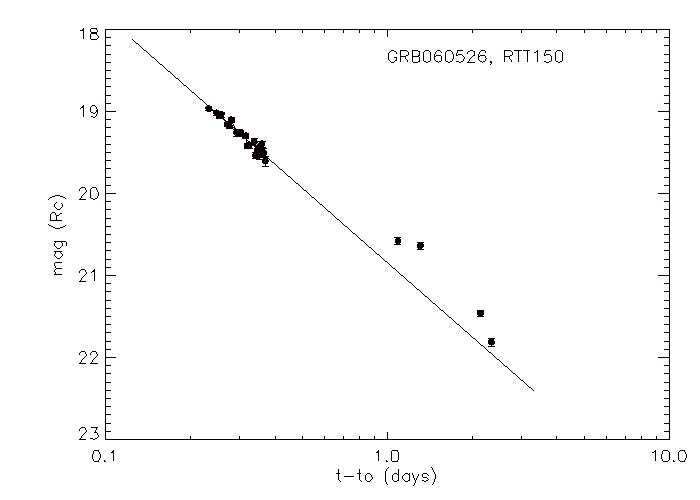
- GCN Circular #5185
K.S. Baliyan, S. Ganesh, H.O. Vats and J.K. Jain (MIRO-PRL, Ahmedabad,
India) report:
We observed the field around position of the optical counterpart of
GRB060526 (Campana et al. GCN 5162, 5163; French & Jelinek GCN 5165;
Rykoff et al. GCN 5166) beginning at 21:02 UT. The 1296*1154 CCD mounted
on the 1.2 M telescope of Mt Abu IR Observatory, operated by Physical
Research Laboratory, Ahmedabad- India, was used to observe OT in VRI bands
with 180 second exposures.
The afterglow is detected clearly in all the bands.
We use Rc=16.484+/-0.01 mag for USNO B-1 star (RA=15:31:18.6, DEC=+00 17 34.9)
as reference value to estimate preliminary R magnitudes for OT on May 26:
21:02:59 UT 18.65 +/- 0.19
21:09:26 UT 18.71 +/- 0.32
21:32:38 UT 19.06 +/- 0.19
22:44:22 UT 19.19 +/- 0.24
This message may be cited.
- GCN Circular #5186
I. Khamitov (TUG), I. Bikmaev, N. Sakhibullin (KSU/AST),
Z. Aslan (TUG), U. Kiziloglu (METU), E. Gogus (Sabanci Uni.),
R. Burenin, M. Pavlinsky, R. Sunyaev (IKI)
report:
We observed the optical counterpart of GRB060526 (Campana et al. GCN
5162; French & Jelinek GCN 5165; Rykoff et al. GCN 5166) with
Russian-Turkish 1.5-m telescope (RTT150, Bakirlitepe,TUBITAK National
Observatory, Turkey), starting at May. 29, 18:44UT, i.e. ~74.26 hours
after the burst. A series of frames were taken. The afterglow is
detected in Rc band and marginally in V.
We estimate the following Rc magnitudes for the OT:
t-t0 m_R err
76.03 22.19 0.07
78.13 22.31 0.07
80.40 22.45 0.12
These points lie approximately on the extrapolation of the first day
power law decay (e.g., Khamitov et al., GCN 5173).
Our Rc lightcurve can be found at:
http://hea.iki.rssi.ru/grb/060526/lc_0529.jpg
This message may be cited.
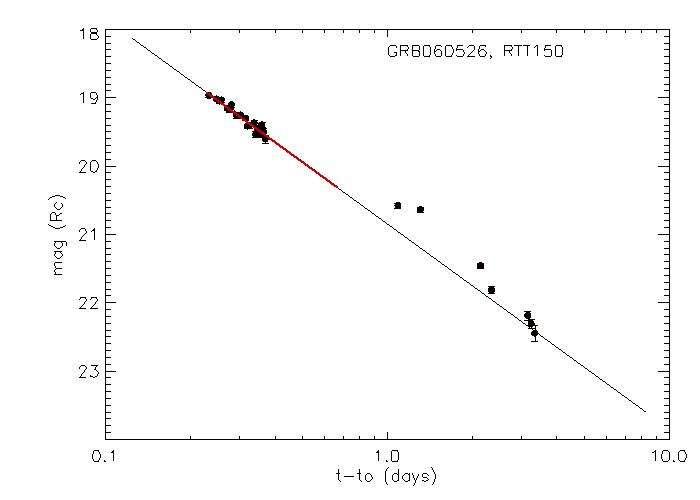
- GCN Circular #5187
D. A. Kann (TLS Tautenburg) and C. C. Thoene (DARK Cosmology Center)
report:
Gathering further data from the GCN (Khamitov et al., GCN 5183, 5186,
Baliyan et al., GCN 5185) in addition to those referenced in Kann &
Hoegner (GCN 5182), we perform fits to the R afterglow light curve.
A single power law fit to all data beyond 6000 seconds yields alpha = 1.04
+/- 0.01, but the late-time data beyond two days lie significantly beneath
the fit.
A broken power law gives a better fit, with alpha_1 = 0.98 +/- 0.10,
alpha_2 = 2.06 +/- 0.13, and break time t_b = 1.76 +/- 0.1 days. The break
smoothness parameter n is fixed to 10.
Still, the fit is not acceptable, with strong deviations around 0.5 days.
Fitting separate parts of the light curve, we find a better fit with a
double broken power law. The first part (0.19 to 1.1 days) is described by
alpha_1 = 1.35 +/- 0.07, alpha_2 = 0.85 +/- 0.08 and t_b = 0.44 +/- 0.08
days, n = -10 fixed. The fit is marginally acceptable, with
deviations due to scatter (different zero points and comparison stars).
The second part (0.53 days to the end) is described by alpha_1 = 0.76 +/-
0.04, alpha_2 = 1.87 +/- 0.07 and t_b = 1.42 +/- 0.08 days, n = 10 fixed.
This fit is acceptable. Alpha_2 of the first part and alpha_1 of the
second part are identical within errors, as expected. We note that the
extension of this last fit to early times is consistent with the first
ROTSE data point (Rykoff et al., GCN 5166) and marginally consisten with
the very early Watcher data (French & Jelinek, GCN 5165).
This strengthens the picture that the break first described by Thoene et
al. (GCN 5179) is the jet break. The post-break decay is relatively
smooth.
We caution that these fits do not include the dense data set presented by
Halpern, Armstrong & Mirabal (GCN 5176) and the optical flare they
detected. Similar to early fits of GRB 030329 presented in the GCN, these fits may
be the result of inhomogenous coverage of a highly variable light curve.
Further deep monitoring is encouraged.
The plots for the double broken power law fits can be found at
www.astro.ku.dk/~cthoene
- GCN Circular #5188
J. P. Halpern (Columbia U.), E. Armstrong (UCSD), & N. Mirabal (U. Michigan)
report on behalf of the MDM Observatory GRB follow-up team:
"We have continued to observe the afterglow of Swift GRB 060526 (Campana
et al. GCN 5162) in the R-band for four consecutive nights using the
MDM 1.3m. In combination with the GCN reported R-band photometry of
Khamitov et al. (GCNs 5173,5177,5183,5186), it is evident that there have
been at least four flares, by which we mean alternating positive and
negative deviations from a mean decay rate. These are characterized
as increases and decreases of at least 0.3 mag in as short a time as
delta t = 0.04*(t-t0), where t0 is the burst time. In view of these
flares, it is problematic to fit a small number of power-law segments
(as noted by Kann & Thoene GCN 5187). Rather, we observe that the most
recent point, r' = 22.87+/-0.07 on May 30 04:23 UT as calibrated with
Cool et al. (GCN 5164) data, falls only 0.25 mag below the -1.18 power
law originally fitted from 5.6 to 16 hours by Khamitov et al. (GCN 5173)
and Halpern et al. (GCN 5176). Other details of the MDM optical light
curve and incorporated GCN data can be seen at:
http://www.astro.columbia.edu/~jules/grb/060526/
This type of light curve is not uncommon in GRB afterglows (see, e.g.,
Stanek et al. astro-ph/0602495, and references therein), and is often
apparent when the source is well placed for long observing runs at
ground-based telescopes."
- GCN Circular #5189
I. Khamitov (TUG), I. Bikmaev, N. Sakhibullin (KSU/AST),
Z. Aslan (TUG), U. Kiziloglu (METU), E. Gogus (Sabanci Uni.),
R. Burenin, M. Pavlinsky, R. Sunyaev (IKI)
report:
We continue our observations of the optical counterpart of GRB060526
(Campana et al. GCN 5162; French & Jelinek GCN 5165; Rykoff et al. GCN 5166)
with Russian-Turkish 1.5-m telescope (RTT150, Bakirlitepe,TUBITAK National
Observatory, Turkey). A series of frames were taken on May 30. The afterglow
is detected on combined images in both V and R bands.
We estimate the following Rc magnitudes for the OT:
t-t0 m_R err
104.05 23.14 0.09
Our Rc lightcurve can be found at:
http://hea.iki.rssi.ru/grb/060526/lc_0530.jpg
In combination with MDM 1.3-m observations (Halpern et al., GCN 5188) these
data suggest that the OT light curve can not be fitted by a combination of
power laws and contain several optical flares.
This message may be cited.
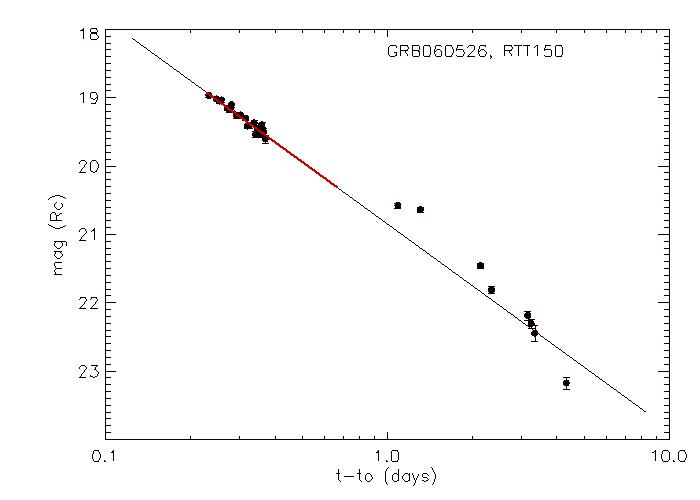
- GCN Circular #5192
F. Terra (Second University of Roma "Tor Vergata"), G. Greco,
C. Bartolini, A. Guarnieri, A. Piccioni (Bologna University),
D. Nanni (INAF/OAR and Second University of Roma "Tor Vergata"),
I. Bruni, S. Galleti (Bologna Observatory) and G. Pizzichini
(INAF/IASF Bologna) report:
"We observed the field of GRB 060526 (Campana et. al., GCN 5162)
with the 152 cm Cassini Telescope located in Loiano, equipped
with BFOSC in the nights april 26-27 (seeing 2".0) and 27-28
(seeing 1".7).
The photometry is based on the SDSS stars (Cool et al. GCN 5164)
and trasformation derived from Lupton (2005). Using this
transformation we find for the USNO B-1 star (RA = 15 31 18.6,
DE = +00 17 34.9) the magnitude Rc = 16.50, consistent with the
calibration of Khamitov et al. (GCN 5177).
We find the following magnitudes:
Mean...UT .......Filter........Exptime (s).......magnitude
May...26.908........Rc............900............18.85+/-0.08
May...26.921........Rc............900............18.92+/-0.07
May...26.935........V............1200............19.37+/-0.08
May...26.949........I.............900............18.60+/-0.06
May...26.961........Rc............900............19.08+/-0.07
May...26.975........V............1200............19.64+/-0.09
May...26.990........I.............900............18.80+/-0.06
May...27.002........Rc............900............19.28+/-0.09
May...27.017........V............1200............19.79+/-0.11
May...27.031........I.............900............18.94+/-0.08
May...28.002........Rc............900............20.61+/-0.13
May...28.017........Rc............900............20.44+/-0.10
- GCN Circular #5193
I. Khamitov (TUG), I. Bikmaev, N. Sakhibullin (KSU/AST),
Z. Aslan (TUG), U. Kiziloglu (METU), E. Gogus (Sabanci Uni.),
R. Burenin, M. Pavlinsky, R. Sunyaev (IKI)
report:
We continue our observations of the optical counterpart of GRB060526
(Campana et al. GCN 5162; French & Jelinek GCN 5165; Rykoff et al. GCN
5166) with Russian-Turkish 1.5-m telescope (RTT150, Bakirlitepe,TUBITAK
National Observatory, Turkey). A series of frames were taken on May
31. The afterglow is detected on combined images in both V and R bands.
We estimate the following Rc magnitudes for the OT:
t-t0 m_R err
125.74 23.69 0.19
Our Rc lightcurve can be found at:
http://hea.iki.rssi.ru/grb/060526/lc_0531.jpg
This message may be cited.
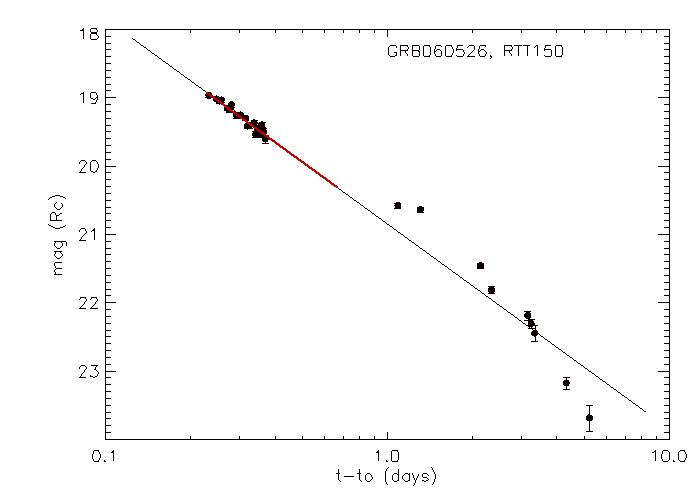
- GCN Circular #5194
A. Moretti (INAF-OAB), D.N. Burrows (PSU) , S. Campana (INAF-OAB),
G. Chincarini (UNIMIB, INAF-OAB), and G. Tagliaferri (INAF-OAB)
report on behalf of the Swift XRT team:
We have analyzed six days of Swift XRT data from GRB 060526
(Campana et al., GCN5162), with a total exposure of 70ks. After the
flaring episodes between 200s and 400s interval from the trigger,
already reported in Campana et al. (GCN 5168), the light curve
presents a shallow decay with slope -0.7(+-0.1) until (1.1+-0.3)e5
seconds after the trigger (1.2+-0.3 days). Superimposed on the
shallow decay a small bump is present at 7 ks.
At (1.1+-0.3)e5 seconds the light curve breaks to a much steeper slope
of (-2.8+-0.1). We note that this slope is very similar to the optical decay
slope of the last five data points obtained by the RTT150 telescope
(Khamitov et al., GGNs 5186, 5189, and 5193, slope ~ -2.75), and that the
X-ray break time also seems to correspond roughly to a break in the
general trend of the optical light curve (e.g., Thoene et al., GCN 5179;
Kann and Hoegner, GCN 5182; Kann and Thoene, GCN 5187;
although the slopes reported in these circulars are shallower than
those seen in the XRT light curve and in the last 5 RTT150 data points).
On the other hand, the optical light curve is quite complex
(Halpern, Amstrong, and Mirabel, GCNs 5176, 5188).
If interpreted as a jet break, the jet opening half-angle for this burst is
about 4.7 degrees x (Eiso/10^53)^(-1/8) x (n/10 cm^-3)^(1/8).
Using the total BAT fluence, we obtain Eiso = 2.3e52 ergs
(15-150 keV observed frame), which would correspond to 5.6 degrees
for the jet opening angle. We did not extrapolate Eiso into the usual
energy band due to the limited energy range of the BAT and the single
power law fit to the BAT spectrum, but we expect that the jet angle
should be in the range of 4-5 degrees. A lower density would reduce
this angle.
This Circular is an official product of the Swift XRT Team.
- GCN Circular #5202
D. A. Kann and U. Laux (Thueringer Landessternwarte Tautenburg) report:
We observed the location of the afterglow of GRB 060526 (Campana et al.,
GCN 5162) with the Tautenburg 1.34m Schmidt telescope. Observing
conditions were mediocre. While it was clear, transparency was low and sky
background was high due to moonlight and light pollution.
We obtained 20 x 600 sec exposures for a total integration time of 12000
seconds. Observations commenced on June 2, 21:04:17 UT and ended June 3,
00:55:07 UT. Midexposure time is June 2.9546, which is 7.2682 days after
the burst.
We do not detect the optical afterglow. Using the USNO calibration star
from Khamitov et al., GCN 5177, we derive the following 2 sigma limiting
magnitude:
t-t_0 Rc limit
7.2682 > 23.5
As Khamitov et al. (GCN 5193) already found a similar magnitude of the
afterglow two days earlier, this limit can only constrain that no further
very bright flares have occured.
No further observations are planned.
This message may be cited.
- GCN Circular #5266
D. Sharapov (MAO and NOT, La Palma), T. Augusteijn (NOT, La Palma),
A.Pozanenko (IKI), V.Rumyantsev (CrAO) on behalf of larger GRB follow up
collaboration report:
We observed the error box of GRB060526 (Campana et al. GCN5162) in Nordic
Optical Telescope with ALFOSC between (UT) June 05 23:37 and June 06 00:41.
We do not detect the optical afterglow. Limiting magnitude of a combined
image of total exposure 10x300 is R~ 24.6. Based on last 3 points of TT150
(Khamitov et al. GCNs 5186, 5189, 5193) the limiting magnitude R=24.6 at
mid time (UT) June 06.0125 (T0+10.486d) is compatible with X-ray power law
decay index 2.8+/-0.1 (Moretti et al., GCN5194). While no sources are
detected within refined XRT error circle (Campana et. GCN5168) faint
galaxy (R=24.4 +/- 0.3) is detected at (J2000) RA = 15:31:18.2 Dec =
+00:17:12.7. Taking into account redshift of the OT of GRB060526 z=3.21
(Berger and Gladders GCN5170) it is unlikely that the
detected galaxy is connected with GRB060526.
The combined image can be found at
http://grb.rssi.ru/GRB060526/
- GCN Circular #5306
V.Rumyantsev (CrAO), A.Pozanenko (IKI), M.Ibrahimov, I.Asfandyarov (MAO) on
behalf of larger GRB follow up collaboration report:
We observed the afterglow of GRB060526 (Campana et al. GCN5162) in Maidanak
Astronomical Observatory (MAO) with 1.5 m telescope in R and B-passbands on
May 26-31, and June 1-2. Additinnaly we recalibrated observation with CrAO
Shajn 2.6m telescope (Rumyantsev et al. GCN5181). A photometry is based on
the star USNO B1.0 RA=15 31 18.60 DEC=+00 17 35.00 R2=16.35 B2=16.42
already used in GCNs (Khamitov GCN5173, Morgan GCN5175, Kann GCN5172,
Baliyan GCN5185). R-band photometry of the afterglow and upper limits are
following:
Mid_time (UT), Telescope, R_mag
26.7778 MAO1.5 17.98 +/- 0.01
26.7829 MAO1.5 18.06 +/- 0.01
26.7883 MAO1.5 18.11 +/- 0.01
27.7799 CrAO2.6 20.38 +/- 0.07
27.8143 CrAO2.6 20.47 +/- 0.06
27.8233 MAO1.5 20.43 +/- 0.04
28.8014 MAO1.5 21.31 +/- 0.13
29.8053 MAO1.5 22.06 +/- 0.11
30.8049 MAO1.5 22.84 +/- 0.24
31.7938 MAO1.5 23.52 +/- 0.32
01.8318 MAO1.5 >23.6
02.8648 MAO1.5 >23.8
The afterglow is clearly detected in B-filter up to May 29; B-photometry
is underway.
The message may be cited.
- astro-ph/0609269 from 10 Sep 2006
Dai: Optical and X-Ray Observations of GRB 060526: A Complex Afterglow with An Achromatic Jet Break
We obtained 98 R-band and 18 B, r', i' images of the optical afterglow of GRB
060526 (z=3.21) with the MDM 1.3m, 2.4m, and the PROMPT telescopes in Cerro
Tololo over the 5 nights following the burst trigger. Combining these data with
other optical observations reported in GCN and the Swift-XRT observations, we
compare the optical and X-ray afterglow light curves of GRB 060526. Both the
optical and X-ray afterglow light curves show rich features, such as flares and
breaks. The densely sampled optical observations provide very good coverage at
T>1.e4 sec. We observed a break at 2.4e5 sec in the optical afterglow light
curve. Compared with the X-ray afterglow light curve, the break is consistent
with an achromatic break supporting the beaming models of GRBs. However, the
pre-break and post-break temporal decay slopes are difficult to explain in
simple afterglow models. We estimated a jet angle of \theta_j ~ 7 degrees and a
prompt emission size of R_{prompt} ~ 2e14 cm. In addition, we detected several
optical flares with amplitudes of \Delta m ~ 0.2, 0.6, and 0.2 mag. The X-ray
afterglows detected by Swift have shown complicated decay patterns. Recently,
many well-sampled optical afterglows also show decays with flares and multiple
breaks. GRB 060526 provides an additional case of such a complex, well observed
optical afterglow. The accumulated well-sampled afterglows indicate that most
of the optical afterglows are complex.
- astro-ph/0609450 from 15 Sep 2006
Jakobsson et al: HI column densities of z > 2 Swift gamma-ray bursts
Context: Before the launch of the Swift satellite, the majority of the gamma-ray burst (GRB) afterglows for which Ly-alpha was redshifted into the observable spectrum showed evidence for a damped Ly-alpha absorber. This small sample indicated that GRBs explode either in galaxies, or regions within them, having high neutral hydrogen column densities.
Aims: To increase the spectroscopic sample of GRBs with z > 2 and hence establish the N(HI) distribution along GRB lines-of-sight.
Methods: We have obtained six z > 2 GRB afterglow spectra and fitted the Ly-alpha absorption line in each case to determine N(HI). This has been complemented with 12 other Swift N(HI) values from the literature.
Results: We show that the peak of the GRB N(HI) distribution is qualitatively consistent with a model where GRBs originate in Galactic-like molecular clouds. However, a systematic difference, in particular an excess of low column-density systems compared to the predictions, indicates that selection effects and conditions within the cloud (e.g. strong ionization) influence the observed N(HI) range. We also report the discovery of Ly-alpha emission from the GRB 060714 host, corresponding to a star-formation rate of approximately 0.8 M_Sun/year. Finally, we present accurate redshifts of the six bursts: z = 3.240 +/- 0.001 (GRB 050319), z = 2.198 +/- 0.002 (GRB 050922C), z = 3.221 +/- 0.001 (GRB 060526), z = 3.425 +/- 0.002 (GRB 060707), z = 2.711 +/- 0.001 (GRB 060714) and z = 3.686 +/- 0.002 (GRB 060906).
- 0802.1635from 12 Feb 2008
Khamitov: Observations of GRB 060526 Optical Afterglow with Russian-Turkish 1.5-m Telescope
Abstract: We present the results of the photometric multicolor observations of GRB
060526 optical afterglow obtained with Russian-Turkish 1.5-m Telescope (RTT150,
Mt. Bakirlitepe, Turkey). The detailed measurements of afterglow light curve,
starting from about 5 hours after the GRB and during 5 consecutive nights were
done. In addition, upper limits on the fast variability of the afterglow during
the first night of observations were obtained and the history of afterglow
color variations was measured in detail. In the time interval from 6 to 16
hours after the burst, there is a gradual flux decay, which can be described
approximately as a power law with an index of -1.14+-0.02. After that the
variability on the time scale \delta t < t is observed and the afterglow
started to decay faster. The color of the afterglow, V-R=~0.5, is approximately
the same during all our observations. The variability is detected on time
scales up to \delta t/t =~ 0.0055 at \Delta F_\nu/F_\nu =~ 0.3, which violates
some constraints on the variability of the observed emission from
ultrarelativistic jet obtained by Ioka et al. (2005). We suggest to explain
this variability by the fact that the motion of the emitting shell is no longer
ultrarelativistic at this time.
- 0806.1182from 6 Jun 2008
Thoene: Photometry and Spectroscopy of GRB 060526: A detailed study of the afterglow and host of a high-redshift gamma-ray burst
Abstract: With this paper we want to investigate the highly variable afterglow light
curve and environment of Gamma-Ray Burst (GRB) 060526 at z=3.221. We present
one of the largest photometric datasets ever obtained for a GRB afterglow,
consisting of multi-color photometric data from the optical to the NIR. The
data set contains 218 data points in total to which we add additional data from
the literature. Furthermore, we present low-resolution high signal-to-noise
spectra of the afterglow. The afterglow light curve is modeled with both an
analytical model using broken power-law fits and with a broadband numerical
energy injection model. The absorption lines detected in the spectra are used
to derive column densities using a multi-ion single-component curve-of-growth
analysis from which we derive the metallicity of the host of GRB 060526. The
overall light curve follows a broken power-law with a break at t = 2.401 +-
0.061 days. It shows deviations from the smooth power-law that can be explained
by additional energy injections from the central engine. The broadband SED of
the afterglow shows little extinction along the line of sight. The metallicity
derived from S II and Fe II is relatively high for a galaxy at that redshift
but comparable to the metallicity of other GRB hosts at similar redshifts.
There is a candidate host galaxy at a relatively large offset of 7.7 kpc from
the afterglow position with R =26.4 mag which would imply a rather luminous
host.
![]() Previous IAU Circulars
Previous IAU Circulars 



















